- Games, topic printables & more
- The 4 main speech types
- Example speeches
- Commemorative
- Declamation
- Demonstration
- Informative
- Introduction
- Student Council
- Speech topics
- Poems to read aloud
- How to write a speech
- Using props/visual aids
- Acute anxiety help
- Breathing exercises
- Letting go - free e-course
- Using self-hypnosis
- Delivery overview
- 4 modes of delivery

How to make cue cards
- How to read a speech
- 9 vocal aspects
- Vocal variety
- Diction/articulation
- Pronunciation
- Speaking rate
- How to use pauses
- Eye contact
- Body language
- Voice image
- Voice health
- Public speaking activities and games
- Blogging Aloud
- About me/contact
- Speech delivery
Cue cards for public speaking
How to make cue cards & use them effectively.
By: Susan Dugdale
Making good cue cards from standard office supply index or note cards to help you confidently deliver an extemporaneous speech is relatively easy. And using them well will lift the quality of your presentation immeasurably. (Truly! I promise you that's not hyperbole. ☺)
What's on this page
Step-by-step guidelines on how to make cue cards and use them well:
- what are cue cards ?
- the benefits of using cue cards
- the materials required to make cue cards
- the 10 features of an effective cue card
- how to write up cue cards - the 3-step process to get from a speech outline to cue cards that work the way you want them to
- how to rehearse with cue cards
- the difference between cue cards and flash cards
What are cue cards?
Cue * or note cards, used by speakers when making an extemporaneous speech * , are typically handheld. They are about 4 inches by 6 inches in size, with carefully selected and ordered words and phrases written on them. These act as prompt to help speakers remember what they have to say.
* A cue is a signal or a prompt to say or do something. * extemporaneous speech -a well-prepared speech that relies on research, clear organization, and practiced delivery, but is neither read nor completely memorized.
The benefits of using cue cards
People who do not use cue cards to help them deliver a prepared speech either read it from a word-for-word printout or rely entirely on their memory.
However, both these delivery methods have potential traps for the unwary.
- Reading a speech well is a skill and like any skill it needs work to become proficient at it. Someone who hasn't practiced reading aloud is very likely to be difficult to listen to and to watch.
- Opting to deliver a speech entirely from memory is only effective if you've done enough practice. A blank-out and trying to chase down lost words in front of an audience can be hard to recover from. (There is no safety-net!)
Enter cue cards!
The benefits of using cue cards well are:
- Not being anchored to a podium reading the entire text of your speech. This enables you to freely interact with your audience: -to make eye contact, -to observe and readily respond, for instance to clarify a point you can see has not been understood, to leave out bits you can tell are not wanted or needed..., -to gesture and move easily.
- Not being left stranded and floundering because you have forgotten important details, or the sequence of your material. Cue cards are reassuring.
A well-prepared set of cue cards will give you confidence. You will sound, look and feel more present, and your entire delivery will have more life, more energy!
For those of you who are nervous about making the transition from the safety of a complete sentence by sentence script to note cards, don't be. Take it slowly. Give yourself time to thoroughly prepare and rehearse with them, and you'll be delighted with the result.
The materials needed
You'll need a packet of standard index cards, similar to the one in the illustration below, a selection of highlighters, (for example, yellow, pink, blue and green), and an easily-read pen. I suggest using one with either blue or black ink.
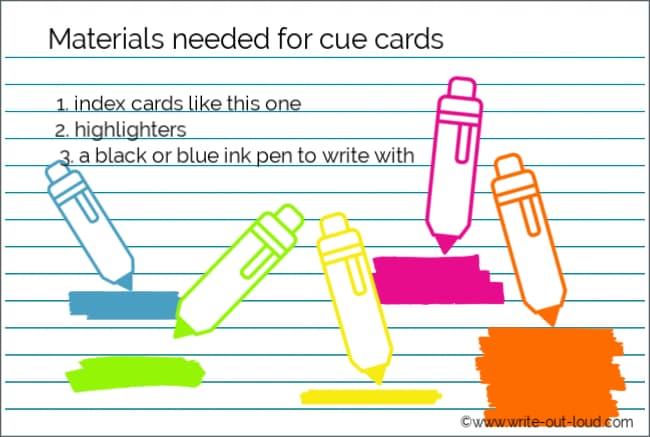
The 10 features of good cue cards
The information you put on your cards and how you lay it out is critically important. You need to be able to read and understand them at a glance. (See the illustration below)
The most user-friendly cue cards:
- have ONE main subject heading or idea per card
- have a heading showing which part of the speech the card belongs to
- are written or printed clearly using larger than usual font - so you can read them easily
- have plenty of white space around each word or phrase to help them stand out
- use bullet points or numbers to itemize the supporting ideas under the main heading
- are written on ONE side of the card only
- are clearly numbered so that you know the order they come in and it can be a good idea to tie them together . Use a hole punch to make a hole through the left corner of your cards and tie with a loop of string long enough to allow them to be flipped. The advantage of that is if you drop or somehow get them out of sequence, you're not scrabbling around trying to get them back into the right order and find where you'd got up to while being watched. That can be tough with dozens of pairs of eyes on you!
- are color-coded to show your main idea, supporting ideas, examples and transitions or links.
- have where props are to be shown . For example: Main Idea One - Supporting Idea - Example - Show slide 1
- have approximate timings marked so you can track yourself through your allotted time. If you find you're going over you can adjust by leaving out an extra example or conversely if you're under time, you can add one in.
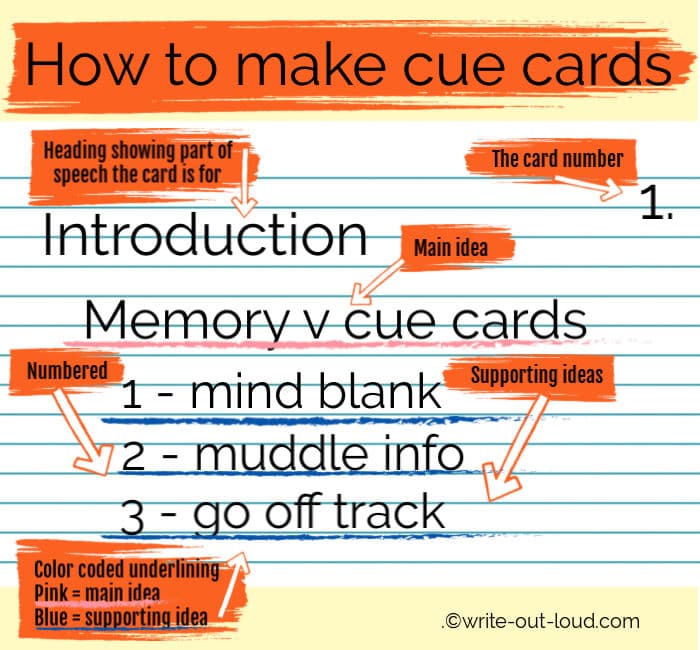
Preparing your speech for cue cards
Before starting the cue cards you need to make sure your speech is fully prepared.
The next 3 steps are an essential part of the preparation process.
1. Reviewing your speech outline
Using your speech outline go through from the beginning checking the sequence of ideas, supporting material and transitions to ensure all your information is in an effective and logical sequence. (And if you haven't made an outline yet download and use the blank one available from the link below.)
Have you outlined your speech?
If you haven't got a speech outline already prepared ...
Use the printable blank speech outline template you'll find on this page: sample speech outline . It will make preparing your cue cards a breeze.
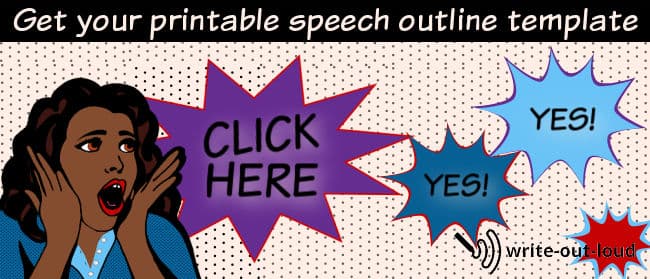
2. Try your speech out loud
Use your outline to try your speech out loud. Say it through as if you were actually giving it and time yourself.
Remember to allow for pausing, waiting for the audience to finish laughing before you begin talking again, and so on.
You may need to edit if it's too long and it's a lot easier to do that at this stage.
3. Feedback
Once you have the length right for your time allowance, ask a few people whose judgment you trust to listen to you give your speech. Have them give you feedback on its content, structure and delivery, paying particular attention to the introduction and the close.
(For more information see speech evaluation| giving and receiving meaningful feedback .)
Use the feedback you've been given to rework your speech if you need to.
When you're satisfied you have it the best it can possibly be, you're ready to prepare it for cue cards.
Getting from outline to writing up your cue cards
Identifying good keywords and phrases.
Each segment or part of your speech, from its introduction to conclusion, should be reducible to a key word or phrase. The phrase or keyword will act as a prompt, or trigger, making you immediately remember what it was you wanted to say.
Before you can write your cue cards you need to go through your speech outline and choose a word or phrase that best represents what each part is about.
Once you've finished, you're ready to write up your cards using the 1-10 guidelines above.
Test your cards as you make them
Double check the effectiveness of each card as you write them to make sure you are using keywords or phrases that actually do trigger your memory.
This is also particularly important for links or transitions. Forgetting how you got from one piece of information to the next not only leaves you stranded but your audience as well.
NB. Be sure to note the names of important people, facts or processes too.
A word of warning
Do not be tempted to print or write the whole of your speech out, then cut it into bits and stick those bits onto cue card sized pieces of cardboard. * It will defeat your purpose entirely.
You'll finish with ridiculously cramped notes that, as well as being difficult to read, stop you from freely interacting with your audience. You'll be head down trying to decipher what you wrote!
* (I've seen it in action! Occasionally one of my student's would try it and the result was never, ever good.)
Rehearsing with your cue cards

You'll find a full page here on ' how to rehearse ' .
It includes notes specifically on rehearsing using your cue cards as well as other valuable tips for delivering your speech successfully.
Now that you've completed your set of cards, please don't shortchange yourself by assuming you are fully prepared and ready for delivery.
To use them well you really do need to practice with them. Before you give your speech aim for at least three concentrated rehearsal sessions and do more if possible.
Cue cards and flash cards. What's the difference?
The principal difference between them is their purpose.
Flash cards are used to help memorize information for example, vocabulary lists for a new language you're learning, the sequence of events leading to the outbreak of WW2, or the names and placement of all the bones in the human body.
They frequently have diagrams and pictures as well as words on them to make the information easier to remember.
The goal or purpose of them is instant recall. They are extensively used by students, particularly as part of their exam preparation.
In comparison, cue cards are generally larger than flash cards and have less information on them - just an ordered sequence of a speech's key words and phrases.
Whereas flash cards are used prior to an examination or test, cue cards are used during a presentation. Their purpose is to prompt or remind the speaker to say what they wanted to.
speaking out loud
Subscribe for FREE weekly alerts about what's new For more see speaking out loud

Top 10 popular pages
- Welcome speech
- Demonstration speech topics
- Impromptu speech topic cards
- Thank you quotes
- Impromptu public speaking topics
- Farewell speeches
- Phrases for welcome speeches
- Student council speeches
- Free sample eulogies
From fear to fun in 28 ways
A complete one stop resource to scuttle fear in the best of all possible ways - with laughter.

Useful pages
- Search this site
- About me & Contact
- Free e-course
- Privacy policy
©Copyright 2006-24 www.write-out-loud.com
Designed and built by Clickstream Designs
- PRO Courses Guides New Tech Help Pro Expert Videos About wikiHow Pro Upgrade Sign In
- EDIT Edit this Article
- EXPLORE Tech Help Pro About Us Random Article Quizzes Request a New Article Community Dashboard This Or That Game Happiness Hub Popular Categories Arts and Entertainment Artwork Books Movies Computers and Electronics Computers Phone Skills Technology Hacks Health Men's Health Mental Health Women's Health Relationships Dating Love Relationship Issues Hobbies and Crafts Crafts Drawing Games Education & Communication Communication Skills Personal Development Studying Personal Care and Style Fashion Hair Care Personal Hygiene Youth Personal Care School Stuff Dating All Categories Arts and Entertainment Finance and Business Home and Garden Relationship Quizzes Cars & Other Vehicles Food and Entertaining Personal Care and Style Sports and Fitness Computers and Electronics Health Pets and Animals Travel Education & Communication Hobbies and Crafts Philosophy and Religion Work World Family Life Holidays and Traditions Relationships Youth
- Browse Articles
- Learn Something New
- Quizzes Hot
- Happiness Hub
- This Or That Game
- Train Your Brain
- Explore More
- Support wikiHow
- About wikiHow
- Log in / Sign up
- Education and Communications
- Communication Skills
- Public Speaking
How to Prepare Notes for Public Speaking
Last Updated: May 21, 2023 Fact Checked
This article was co-authored by Deb DiSandro . Deb DiSandro is the Owner of Speak Up On Purpose, an organization dedicated to improving and teaching public speaking. Deb has over 30 years of experience as a national speaker and has presented at the Erma Bombeck Writer’s Conference and the National Society of Newspaper Columnists. She was awarded the National Speakers Association Member of the Year 2007 and has been published in Writer's Digest, Daily Herald, Women's Day, and Better Homes & Gardens. There are 10 references cited in this article, which can be found at the bottom of the page. This article has been fact-checked, ensuring the accuracy of any cited facts and confirming the authority of its sources. This article has been viewed 244,955 times.
You have to give a speech, and you wonder how you can give it without staring at a piece of paper. Rather than memorize the words, you can use notes. Notes are easy to make. First, write and refine your speech. Pick out keywords that represent the main ideas of your speech and write them on notecards. Finish filling out the notecards with important talking points. Good notes make you sound natural as a speaker while having a safety net in case you get lost.
Creating and Breaking Down Your Speech

- This is a draft. Pay attention to word choice and sentence structure. Make it as good as possible, but remember that you'll be able to fix any mistakes before you make your notes.
- Get all of your ideas on paper. It doesn't matter if they're crazy, inspiring, or weird. You have a chance to perfect what doesn't work later on. [2] X Research source

- It's a good idea to time yourself while you do this. That way, you'll know when you need to cut down your speech's length.
- Learn transitional phrases to help your speech flow naturally. [4] X Research source

- Highlight things that worked from your first draft and areas that you want to keep that need to be reworded.

- Record your own speech and listen to the phrases and pacing. Listen for any awkward phrases and try to smooth them out in the next draft.
- If you know someone who's given a public speech before, ask them to listen. They will have more experience and will be less biased.

Making Your Notes

- For example, you are speaking about the life of a politician. You can use the word “Military” to show yourself when it's time to talk about their military experience.
- Images can also help solidify the order of your speech. Visualize uniformed soldiers marching in unison and you won't forget you need to talk about military training.
- Write out the first words of your transition sentences to help keep yourself on track.

- For example, if you need to introduce your second idea at the three minute mark, write three minutes on the card containing that idea.

- Write the words in a pen that's legible to you. Black or blue ink works best.
- If you have bad handwriting, you can type out your notes. Cut and glue them onto your notes or print them directly by using the “Size” option in the “Print Layout” tab.

- For example, write out “award” or “Purple Heart” to remind yourself to mention the awards someone earned in service.

- For instance, write down “75% pass” if you need to inform your audience how many people pass a class.

- Customize the color code to whatever works best for you.
- This works best if you color code while you practice your speech, but it could be distracting or confusing by the time you give the speech.

- You can also bind the cards together. Use a drill or hole punch on the upper left corner of the notes. Loop a string through them. They'll be easy to flip and can't be mixed up.
- However, make sure the flipping of the notecards is not distracting to the audience.
Rehearsing Your Speech

- Memorizing a speech word-for-word is unhelpful because the audience can tell that you're reciting a script. Only use memorization and scripted words if you're painting a picture with your words or you need to tell a joke with comedic timing.

- Because you are using a minimal outline, your speech will sound a little different every time. However, it'll also sound more natural.

- You can time yourself again while giving the speech so you know exactly how long it is rather than making a guess. It can show you when you're going off-script too much. Keep in mind when you give the speech, you're bound to talk faster and the speech will be shorter.
Community Q&A
- Research name pronunciations before writing your speech. Thanks Helpful 4 Not Helpful 1
- Try to have 3 main points in the middle of your speech so the audience remembers it well. You can back these points up with further information or quotes. Thanks Helpful 4 Not Helpful 1
- Look at your card quickly and smoothly. Keep your thumb next to the line on your note card so you don't lose your place. Thanks Helpful 3 Not Helpful 1

- When using visual aids, make them sparse and with few words. Visual aids are supposed to be for the audience. Thanks Helpful 0 Not Helpful 1
Things You'll Need
- Blue or black pen
- Colored highlighters
- Index cards
You Might Also Like

- ↑ https://pac.org/content/speechwriting-101-writing-effective-speech
- ↑ https://wrd.as.uky.edu/sites/default/files/1-Shitty%20First%20Drafts.pdf
- ↑ http://writingcenter.unc.edu/tips-and-tools/speeches/
- ↑ https://open.lib.umn.edu/publicspeaking/chapter/10-2-keeping-your-speech-moving/
- ↑ https://www.unr.edu/writing-speaking-center/student-resources/writing-speaking-resources/editing-and-proofreading-techniques
- ↑ http://www.washington.edu/doit/presentation-tips-0
- ↑ https://examples.yourdictionary.com/keyword-outline-examples.html
- ↑ http://academics.umw.edu/speaking/resources/handouts/preparing-speaking-notes/
- ↑ https://www.ted.com/participate/organize-a-local-tedx-event/tedx-organizer-guide/speakers-program/prepare-your-speaker/rehearsals
- ↑ https://www.student.unsw.edu.au/speaking-audience
About This Article

Public speaking can be scary, but using notes can increase your confidence and make it a little easier. To prepare notes for public speaking, begin by writing your speech. Once you’ve written the first draft, read the speech out loud and make any necessary changes so it sounds smooth. When you’re happy with your speech, translate it into notes by highlighting keywords to mark where each new idea begins. Then, write one keyword per notecard. Make sure your writing is clear so you can read it easily as you speak! If you need to remember specific details or statistics, include these on your notecards. For example, you could write ”75%” in your notes if you need to tell the audience how many people pass a class. When you’ve finished making your notes, number each one to avoid getting them mixed up. For more information from our Public Speaking co-author, like how to practice your speech, read on! Did this summary help you? Yes No
- Send fan mail to authors
Reader Success Stories
Conrad Pickl
Oct 17, 2017
Did this article help you?

Zachary Peel
Sep 19, 2021
Megan White
Jul 27, 2016
Tambra Shafer
Oct 15, 2017
Anahi Pizano
Feb 10, 2020

Featured Articles

Trending Articles

Watch Articles

- Terms of Use
- Privacy Policy
- Do Not Sell or Share My Info
- Not Selling Info
Get all the best how-tos!
Sign up for wikiHow's weekly email newsletter
- Newsletters
- Best Industries
- Business Plans
- Home-Based Business
- The UPS Store
- Customer Service
- Black in Business
- Your Next Move
- Female Founders
- Best Workplaces
- Company Culture
- Public Speaking
- HR/Benefits
- Productivity
- All the Hats
- Digital Transformation
- Artificial Intelligence
- Bringing Innovation to Market
- Cloud Computing
- Social Media
- Data Detectives
- Exit Interview
- Bootstrapping
- Crowdfunding
- Venture Capital
- Business Models
- Personal Finance
- Founder-Friendly Investors
- Upcoming Events
- Inc. 5000 Vision Conference
- Become a Sponsor
- Cox Business
- Verizon Business
- Branded Content
- Apply Inc. 5000 US
Inc. Premium

How to Use Notes When Public Speaking Without Losing Your Audience
Your notes shouldn't become the focus of your presentation..
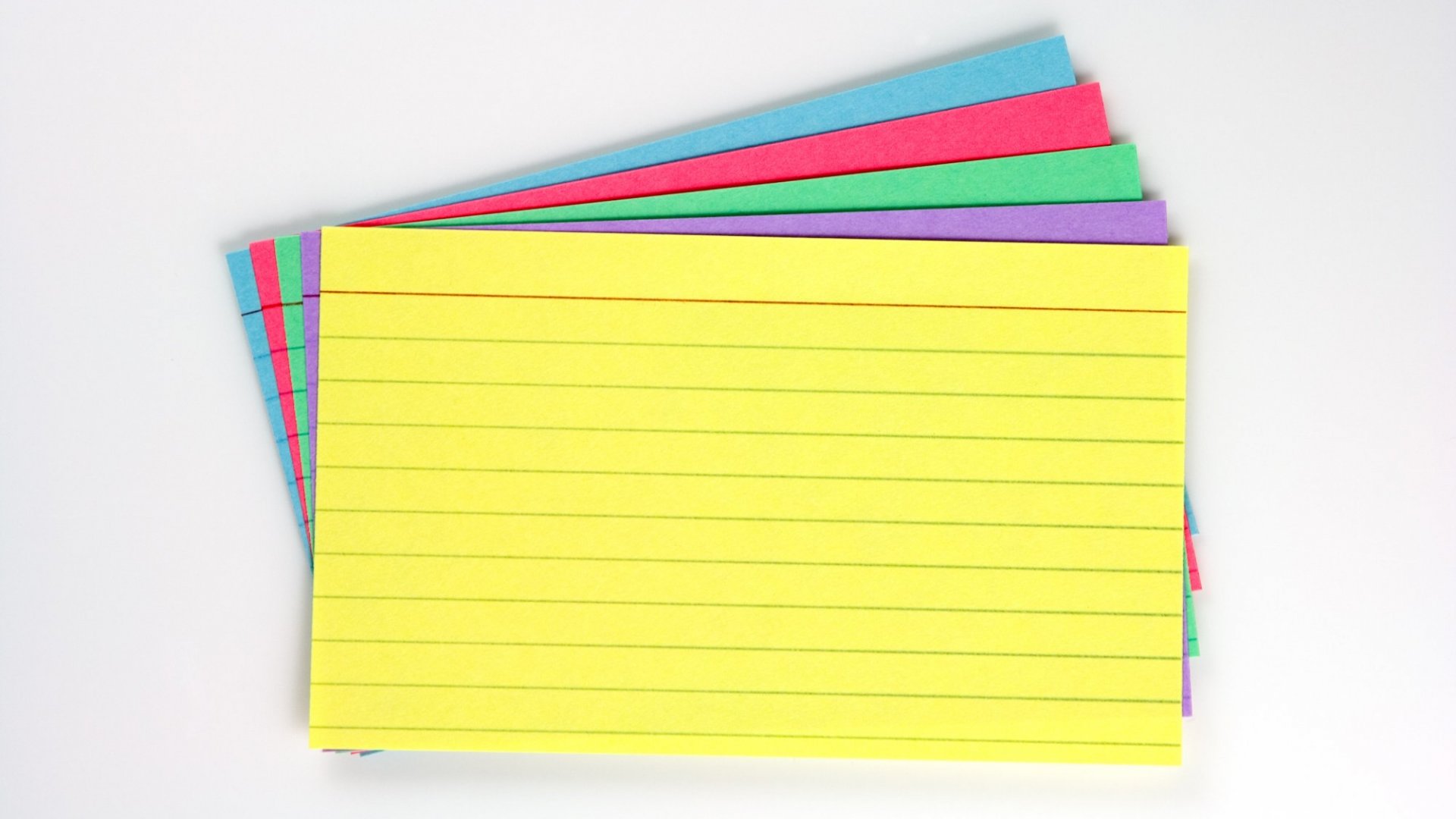
As a professional speaker and speaking coach, I rarely refer to notes while I'm actually speaking, and that's for three reasons: First, it's my job to know my content inside and out. Second, because my presentations are interactive , I have multiple opportunities to check my notes while my audience is doing an activity or having a discussion. Third, having spent seven years performing improvisational comedy , I can usually "wing it" for a few minutes until I gather my thoughts, without the audience noticing.
But if you're not a professional speaker, an interactive workshop leader, or an improvisational comedian, you may find that you need notes to feel more confident presenting. And if you're not lucky enough to have a "confidence monitor" (that flat screen at the foot of the stage that allows a speaker to see his slides without breaking eye contact with the audience) you may have to rely on old-fashioned paper to bring up with you.
Here are 10 tips for successfully speaking with notes so that you're still connecting with the audience more than you're connecting to that piece of paper.
1. Look polished
Make sure any hand-held notes look crisp and professional from the audience's perspective. Don't bring a stack of crumpled up papers with you. Use clean pieces of white computer paper or index cards, on which the ink isn't visible from the back of the page.
2. Write big
Write your notes in large enough font that you can simply glance at them and access the information you need. You don't want to be squinting and scanning the page for the next thing you're trying to say.
3. Number them
Write large page numbers on each sheet of paper or index card. That way, if they get shuffled or out of order, you can quickly find your place.
4. Practice
If your presentation requires you to stand at a podium, practice delivering the presentation so that you're referencing your notes as rarely as possible. Your rehearsal should also prepare you for when you move to the next page. Avoid turning pages in the middle of an important idea, a quotation or a story. Look for natural breaks between main points to turn the page.
5. Plan your moves
If you're going to be moving during the presentation (which I highly recommend), put your notes down on a table or a podium when you're not using them, as long as you won't need them frequently. It's more distracting to watch you keep walking over to pick them up from a table then for you to just hold them in one hand.
6. Choose the right (or left) hand
While you're using notes, hold them in your nondominant hand. Anchor that elbow to your waist and hold your notes firmly, with limited movement. Use your other hand to gesture. Don't gesture with the hand holding your notes--the flapping paper or pile of cards will be a distraction to your audience.
7. Don't read
Your notes shouldn't serve as a script you're reading verbatim. Look at your notes, scan them quickly, and then turn your eye contact back to the audience and resume speaking. Otherwise you'll look like your audience is your stack of index cards.
An exception to "don't read your notes" is when you want to make it clear that you're deliberately reading for the sake of accuracy, such as offering an important statistic or a direct quotation. You might even signal this to the audience by saying something like, "I'd like to read our Vision Statement aloud so that we're all clear on where we're going."
8. Distract from the notes
Think of your notes as a bright shiny object. Chances are, your eyes and your audience's eyes will be drawn to those notes are unless you use them carefully, strategically, and infrequently. Make up for the use of notes with powerful body language and vocal variety.
9. Challenge your assumption
Many presenters discover that their notes are like a security blanket--they thought they needed them for comfort and reassurance, but they realized that they never looked at them throughout the presentation. If you don't need them, don't bring them up with you.
10. Don't apologize
You may wish you didn't need notes, but if you do, then use them without apology. Saying, "I'm sorry that I have my notes up here with me" or "there's too much for me to remember" or, worst of all, "I didn't have time to prepare" undermines your credibility, insults your audience, and draws attention to something you'd rather not highlight.
Mark Twain once wrote: "It usually takes me more than three weeks to prepare a good impromptu speech." Make sure you put the time, energy, and effort into looking and sounding comfortable, prepared, and confident-- even if you're using notes.
A refreshed look at leadership from the desk of CEO and chief content officer Stephanie Mehta
Privacy Policy

Want to create or adapt books like this? Learn more about how Pressbooks supports open publishing practices.
14.3 Using Notes Effectively
Learning objectives.
- Know how to use notecards to free you from your manuscript.
- Know how to use notecards to stay organized while you make audience contact.
- Understand how to develop effective notecards for a speech.

Dave Gray – Blank index card! – CC BY 2.0.
It’s a great deal of work to prepare a good speech, and you want to present it effectively so that your audience will benefit as much as possible. We’ve already said that extemporaneous speaking provides the best opportunity for speaker-audience contact and that speaking extemporaneously means you do not have your full manuscript or outline with you. Instead, you will use notecards. The cards should have notes, not the full text of your speech. This can also be done with an autocue device—the TelePrompTer does not have to provide a full word-for-word script.
We have developed a system for creating highly effective notecards. Our system has been used effectively both in public speaking courses and in freshman composition courses. Surprisingly, the system consists of only five cards. For many people, this does not sound like nearly enough cards. We would make the case that you can do a good job with five cards, and we have seen many students do just that.
The Purpose of Speaker Notes
Using notes adds to your credibility as a speaker. If you depend on a full manuscript to get through your delivery, your listeners might believe you don’t know the content of your speech. Second, the temptation to read the entire speech directly from a manuscript, even if you’re only carrying it as a safety net, is nearly overwhelming. Third, well-prepared cards are more gracefully handled than sheets of paper, and they don’t rattle if your hands tremble from nervousness. Finally, cards look better than sheets of paper. Five carefully prepared cards, together with practice, will help you more than you might think.
Key Tips for Using Notes
Plan on using just five cards, written on one side only. Get 4 × 6 cards. Use one card for the introduction, one card for each of your three main points, and one card for the conclusion.
Include Only Key Words
Your cards should include key words and phrases, not full sentences. The words and phrases should be arranged in order so that you can stay organized and avoid forgetting important points.
One exception to the key word guideline would be an extended or highly technical quotation from an authoritative source. If it is critically important to present an exact quotation, you may add one additional card that will contain the quotation together with its citation. If you plan to use such a quotation, make sure it has central importance in your speech.
Hold Your Notes Naturally
Notes are a normal part of giving a presentation. You do not need to conceal them from the audience; in fact, trying to hide and use your notes at the same time tends to be very awkward and distracting. Some instructors recommend that you avoid gesturing with your notes on the grounds that nervous shaking is more noticeable if you are holding your notes in your hand. If this is the case for you, practice gesturing with your free hand, or put your cards down if you need to use both hands. Other instructors recommend treating notecards as a natural extension of your hand, as they believe it is distracting to put your notes down and pick them up again. Whichever “rule” you follow, remember that the goal is for your use of notecards to contribute to your overall appearance of confidence and credibility.
Prepare Notecards to Trigger Recall
The “trick” to selecting the words to write on your cards is to identify the keywords that will trigger a recall sequence. For instance, if the word “Fukushima” brings to mind the nuclear power plant meltdown that followed the earthquake and tsunami that hit Japan in 2011, then that one word on your notecard should propel you through a sizable sequence of points and details. Once you have delivered that material, perhaps you’ll glance at your card again to remind yourself of the key word or phrase that comes next.
You must discover what works for you and then select those words that tend to jog your recall. Having identified what works, make a preliminary set of five cards, written on one side only. Number the cards, and practice with them. Revise and refine them the way you would an outline. If you must, rewrite an entire card to make it work better, and test it the next time you practice.
Always practice with your notecards—and with any visual aids you plan to use. Practicing is also the best way to find out what kinds of things might go wrong with your notes in the presented speech and what steps you should take to make things go smoothly.
Write in Large Letters
You should be able to read something on your card by glancing, not peering at it. A few key words and phrases, written in large, bold print with plenty of white space between them, will help you. If the lighting in your speech location is likely to have glare, be sure to write your notes in ink, as pencil can be hard to read in poor lighting.
Using Notecards Effectively
If you use as much care in developing your five notecards as you do your speech, they should serve you well. If you lose your place or go blank during the speech, you will only need a few seconds to find where you were and get going again. For instance, if you know that you presented the introduction and the first main point, which centers on the Emancipation Proclamation, you can readily go to your second card and remind yourself that your next main point is about the Thirteenth Amendment to the US Constitution.
In addition, the use of your notecards allows you to depart from the exact prepared wordings in your manuscript. In your recovery from losing your place, you can transpose a word or phrase to make your recovery graceful. It allows you to avoid feeling pressured to say every single word in your manuscript.
Under no circumstances should you ever attempt to put your entire speech on cards in little tiny writing. You will end up reading words to your audience instead of telling them your meaning, and the visual aspect of your speech will be spoiled by your need to squint to read your cards.
Key Takeaways
- Good notecards keep you from reading to your audience.
- Good notecards are carefully based on key words and phrases to promote recall.
- Good notecards should enhance your relationship with listeners.
- Using the introduction to your speech, create a 4 × 6 notecard that includes the grabber, the thesis statement, and the preview. Test it by standing as you would during a speech and using it to guide you.
- Answer these questions: Is it absolutely crucial to utter every word on your outline? Are there some words or phrases that are crucially important? How can you use your notecards to focus on the most important ideas?
- Select key terms from your speech that you believe will trigger your recall of the sequence of main ideas in your speech. Use them as the basis of your next four notecards. Test the cards by practicing with them to see whether your selected terms are the ones you should use.
Stand up, Speak out Copyright © 2016 by University of Minnesota is licensed under a Creative Commons Attribution-NonCommercial-ShareAlike 4.0 International License , except where otherwise noted.
Share This Book

How to Use Notes in a Speech: 14 valuable tips for a speaker
- Filed under: Featured articles , Public speaking articles , Public speaking tips and tricks , Speech delivery , Speech preparation
While we’ve already explored the topic of speaking without notes here on my site, I’ve figured I should add a piece about speaking with notes. After all, there is nothing wrong with using notes in a speech, and it is the preferred method of many speakers. I know that there are a lot of times when I choose to use notes during a speech.
So, how do you use notes in a speech? Realize that notes are just notes, and shouldn’t be the full manuscript of your speech. Cue cards can be very effective when speaking in public. Make sure you are writing down keywords and phrases to remember. Try not to look down at your cards too much.
There are many benefits and also tricks to using notes during your speech. It’s okay if you aren’t experienced with this skill yet, because everyone has to start somewhere. If you’re really serious about learning to properly utilize this in your presentations, then I am going to show you some of my best tips. Read on!
Meanwhile, if you want to be a better public speaker, I have compiled a great list of the best public speaking books you definitely should read. Check out these books here
Table of Contents
How to Use Notes in a Speech
When you are using notes, remember that how you use them is more important than anything. Almost everyone does notes differently, so it can help you to ask for advice from a trusted friend or mentor. And you should always remember to let things flow and be natural. If you are awkward and acting less than natural onstage, your audience could feel uncomfortable.
And above all, if you are in the middle of your speech and something is not going as you planned in your notes? That is perfectly okay. Not everything can be planned for, and sometimes you just have to go with the flow.
#1 Identify if You Need Notes or Not
There may be times when it is more or less appropriate to use notes, or not. For the most part, it is your choice. However, there are some other factors you should consider:
Maybe it is required to use notes
Some places where you speak may explicitly require you not to use notes. This also includes certain formats such as TED talks or short toasts. Make sure to find out whether or not using notes or not using notes is preferable at your venue, and for your style of speech.
It is not allowed to use notes
If you are explicitly not allowed to use notes. This may be the case if you are giving a presentation at school, or a speech as part of a verbal essay.
How long is your speech?
Is your speech too short to warrant the need for notes? Most of the time, speakers don’t use notes if their presentation is less than six minutes or so.
Delivering a keynote speech at a major event, teaching an educational course that is multiple days long, or giving a speech that is too long to memorize are good times that it is appropriate for you to use notes.
When you assess whether or not you should use notes, you avoid a lot of confusion when you show up to give your speech. You also avoid a potentially awkward situation. This goes right along with something that I am always telling my colleagues and students: be prepared!
If you are somehow here because you need to know how to give a speech without notes, check out the article that I have done here about that subject. For the rest of this article, we will exclusively be talking about public speaking with the use of notes. It’s important to say, though, that there is nothing inherently wrong with either method.
Creating and Planning Your Speech is a Great Start
Now, let’s talk about creating and planning your speech with the use of cue cards. If you know anything about me, you know I’m a bit fan of planning your presentation out as much as you can. After all, planning and practice both make perfect!
Here are some steps you should take to plan your speech out with notes using cue cards:
Recommended books
How to Deliver a TED Talk: Secrets of the World's Most Inspiring Presentations
Jeremy Donovan
Resonate: Present Visual Stories that Transform Audiences
Nancy Duarte
Confessions of a Public Speaker
Scott Berkun
Talk Like TED: The 9 Public-Speaking Secrets of the World's Top Minds
Carmine Gallo
The Checklist Manifesto: How to Get Things Right
Atul Gawande
The First 20 Hours: How to Learn Anything... Fast!
Josh Kaufman
#2 What is the purpose of your speech?
Knowing the purpose of your speech is always the first step. What is the reason you are speaking? What cause are you trying to further? Get out a piece of paper, and write the purpose of your speech at the very top in big letters.
This is something you need to keep in mind throughout the entire process so that you don’t lose sight.
#3 Draft and outline
Write a draft with an outline prepared. Make sure to underline or highlight key points of your speech.
#4 Tweak your draft
Go through your draft as many times as possible to add or subtract anything that you need to. Take this time to fix any mistakes you may have made.
#5 Let someone else take a look
Have a friend or mentor look over your draft for you, since they may be able to give you some proofreading tips. If you know someone who is good at writing or is an English major, they may be best able to help you.
#6 Prepare your cards
Then, take your cue cards and write down the key ideas of your outline onto the cards.
Try to select one main idea per card. If you cram too many ideas onto one card, this may end up getting confusing. It could even cause you to lose your place. Also, make sure you are writing legibly at all times.
#7 Prepare for the time limit
If your speech has a time limit, write on each card how much time you should spend on each particular idea.
#8 Number your cards
Number your cards if applicable so you know what order you are going in.
#9 Write Interaction Reminders or Important Facts
As I mentioned before, notes are a better choice than using a scripted speech if you want to maximize the connection with your audience members. That is why it is a good idea to include reminders to interact with your audience on your note cards.
Here are some interaction reminders you could write for yourself:
- “Ask Poll Question”
- “Change Slide”
- “Flip Chart”
- “Give Five Minute Break”
- “Distribute Handout”
And if you have any exact information that you need to remember, such as percentages or names, you should write this down to remember.
When I give this piece of advice, many students have told me that they are worried that writing down interaction reminders with make them look too unnatural or scripted. But interacting with your audience is just as important as what you have to tell them.
With practice, your audience interaction won’t look unnatural even if you have to remind yourself when to do it.
#10 Are You Using PowerPoint Slides?
PowerPoint slides can be very helpful for a lot of things. And while they can be a great visual aid for your audience, you should not use them as a substitution for regular notes.
Why? Well, this will be too much material for your slides. And the PowerPoint is supposed to be used as a visual aid, not as the sole source of information. After all, what do you need to speak for if all of your information is available on your slides?
#11 Practice, practice, practice
When you are completely done writing out your notes, practice reading them during your rehearsal. This will help you identify any possible problems before the day of your presentation.
When you effectively plan out your speech and your note cards, you will be best prepared when the big day comes. And being prepared for your speech is one of the best things you can do.
Notes Aren’t a Manuscript for the Entire Speech
There are times when reading from a full script is appropriate, or required. But in general, notes are considered a better overall way to speak to an audience. Why? Well, that is because notes give you more of an opportunity to be yourself onstage.
Don’t allow your use of notes to reduce how you are able to connect with your audience. What if you are reading from a full script, and someone asks a question that interrupts that script? This is exactly why your notes should only represent a general outline and reminders, not an entire script.
#12 Use bullet points instead of a full script
Here are a few other reasons you should use notes or bullet points instead of a full script:
- Full scripts require you to constantly be looking at a piece of paper, but this looks unnatural . You should be giving some attention to looking at your audience, and focusing on your hand gestures.
- Writing out only specific key phrases can help you remember what you want to talk about , while also giving you some freedom to improvise when needed.
- Not having to look at a full script will give you the freedom to move around the stage.
- You have a guide with notes, but you are not fully committed to the full word-for-word script, which gives you flexibility.
While reading from a full script shouldn’t be completely thought of as bad, I often find that it is easier to talk more freely and connect with the audience better when I am not chained to a script. But the security of having notes or a set of bullet points on hand can help greatly when the time comes.
#13 Cue Cards Help Tremendously
Should you use regular paper, or note card stock?
A regular paper can be great for the planning stages, but you will definitely benefit in the long run from having your notes on smaller cue cards. Cue cards also look more graceful when you are handling them onstage.
Plus, what if you get nervous and your hands start to shake? A larger piece of paper will make the shaking more noticeable to your audience.
Heavy card stock is a good choice. This way, your notes are less likely to blow away if there is a fan, air conditioning, or it is windy and you are outside. However, you should also be prepared to bring a paperweight with you, just in case. You don’t want to end up chasing your notes around instead of giving your speech!
If you are used to giving speeches with a full script, and now you’re looking to switch to note cards, try to give yourself a smooth transition . It might take a little while to get used to doing things differently. This is why rehearsal, asking for help from a mentor and revising your notes many times before the actual speech is good ways to prepare.
#14 Don’t Constantly Look Down at the Notes
Giving eye contact to your audience members is a good way to connect with them during a speech . But constantly looking down at your note cards can have the opposite effect, and make you look more distant.
Throughout your speech, make sure you are putting forth an effort to look out into the audience, make eye contact, and smile. You should also make gestures with your hands, when appropriate. (If you need more tips on what to do with your hands, check this out ).
However, you shouldn’t constantly apologize when you glance down at your notes. Your audience members are forgiving, and they know that sometimes, speakers need to make good use of note cards. Remember, they won’t care that you are using notes , so don’t be self-conscious!
You should not be trying to hide your cards from the audience. If you’re making it look like you have something to hide, you are making yourself look suspicious. Try to treat your note cards like a natural extension of your own hand.
Try recording yourself doing a practice run of your speech. If you notice yourself looking down at the note cards too much, then try making an effort to look out into the audience a bit more.
Is it Professional to Use Notes in My Speech?
After we’ve made it this far, maybe you are still wondering whether or not it is professional for you to use notes when giving a speech. Believe it or not, but I get asked this question all the time from students, friends, and other speakers. It makes me baffled to think that people still believe that using note cards in a speech could be unprofessional.
Listen to me when I say that there is nothing unprofessional about using notes in your speech . In fact, until the rise of the note-less TED talk format, it used to be common for most speakers to use notes during their presentations.
When I speak to students, it seems that they are mostly afraid that using notes indicates a lack of self-confidence. Or worse, they are afraid that they appear uneducated or unprepared. But that couldn’t be further from the truth.
What if you were in the middle of your presentation , and you forgot to talk about a key part? It was very important and forgetting it threw you off track for the rest of the speech.
In the end , your audience was confused about the purpose of your speech, and you came off looking very unprepared. Some people just give better speeches if they have notes. And if that describes you, then you absolutely should have notes.
After all, why put yourself at risk of forgetting something important? If you are worried about the opinions of someone else, don’t be. After all, they are not the ones giving your speech for you, and you have to do what will help you give your best speech.
To many, using notes indicates that you took the time to thoroughly prepare. And if you are new to a topic or inexperienced in the subject material, notes can be a lifesaver for you. So use notes without a worry , because it is absolutely not unprofessional.
Conclusion: How to Use Notes in a Speech?
Today, I hope you have learned something valuable about speaking with notes. Giving a speech with proper notes can be a great way to be prepared for an excellent presentation. As long as you are fully prepared, you have absolutely nothing to worry about. And if you have anything else to share about using notes during a speech, make sure to leave it in the comments section!
Are you looking for good tips to end a speech on a powerful note? Check out my article here , for several tips to properly end a speech. There are also many more articles on how to give a good speech on this website.
Related Questions
Is it okay for me to read a speech? It is usually better for you to read notes instead of an entire speech. If you have to read a full manuscript, that is also okay. Make sure you do what feels comfortable. Leave room to be able to connect with your audience.
How do I prepare for a speech? Make sure you know the purpose of your speech from the beginning. Take time to plan and create your notes if you are using them. Practice and rehearse as much as you possibly can. Rehearse in front of a friend or family member who can give you feedback.
How do I use your my effectively in a presentation? Watch your volume, and be mindful of your intonation. Speak clearly at all times when you are giving a speech. Place emphasis on the right words. Make sure you pace yourself accordingly. Pause when appropriate. (full article here)
Posts about public speaking you may also like

How to Give a Eulogy and Deliver It Like A Pro? 8 Great Tips
Someone significant in your life has passed and it is now time to deliver a eulogy. The responsibility is on your shoulders. Of course, it’s

10 great tips on how to give a killer speech without notes?
If you are a fan of the TED talk format, you may have noticed that most of these speakers give a killer speech without the

7 Main Reasons Why Public Speaking is So Hard
Have you ever had to give a speech or present in front of a group of people and felt your palms sweat, your heart race,
- Tags: Good speech , Illustrating your speech , Making a speech , Prepare a speech , Prepared speech , Presentation techniques , Public presentation , Speech preparation process , Speech skills , Speech writing tips , Unprepared speech topics , Writing a speech
Recommended gear

Best Portable Speakers For The Presentations

Best Video Cameras for Public Speakers

Best rresenter remotes for public speakers

Best Portable Thumb Drives And Hard Drives for the Presentations
Who is janek tuttar.
My name is Janek Tuttar , and I am the founder and author of Speak and Conquer website.
I have been teaching public speaking at Estonian Entrepreneurship University of Applied Sciences
Here, I am sharing the wisdom of how to cope in different public speaking situations.
More information about Janek »

Share this post

Hi! My name is Janek Tuttar, and I am the founder and author of SpeakAndConquer.com.
I have been teaching and blogging about public speaking since spring 2007. Here, I am sharing the wisdom of how to cope in different public speaking situations.
Send me an e-mail: [email protected]
LEGAL INFORMATION
This site is owned and operated by Janek Tuttar. SpeakAndConquer.com is a participant in the Amazon Services LLC Associates Program, an affiliate advertising program designed to provide a means for sites to earn advertising fees by advertising and linking to Amazon.com.
This site also participates in other affiliate programs and is compensated for referring traffic and business to these companies.

Best teleprompters

Best Computer Mice for the Presentations

Best Laptop Backpacks for Public Speakers

Cue Cards Keep Speakers On Track

Cue cards , also known as note cards , contain either the key points of a speech (or the entire text) to help a speaker stay on track or jog the memory if the speaker has not memorized the speech. They can help the speaker pace their talk for extemporaneous speeches.
If you’ve ever given a speech or presentation and forgotten what you intended to say or in what order you wanted to make your points, you understand the usefulness of cue cards. The seemingly insignificant reminders written on what are typically small cards can be a lifesaver in many instances.
Table of Contents
What Are Cue Cards Used For In Speech Making?
Cue cards are an essential tool for public speakers and presenters. They help the speaker remember important points, facts, and figures during a speech or presentation .
Using cue cards, the speaker can maintain eye contact with the audience while delivering a well-organized and coherent message. They also help ensure the speaker doesn’t miss any important information or points during the presentation, which can be crucial when making a persuasive argument or delivering a compelling message.
In some cases, cue cards assist with transitions between different parts of the speech or remind the speaker of specific examples or stories they want to share.
Cue cards come in many variations depending on the speaker’s preference. Some speakers prefer to write their entire speech on cue cards, while others only write down key points or phrases. In some cases, cue cards can take the form of a PowerPoint presentation, in which case the slides can prompt the speaker through each part of the speech.
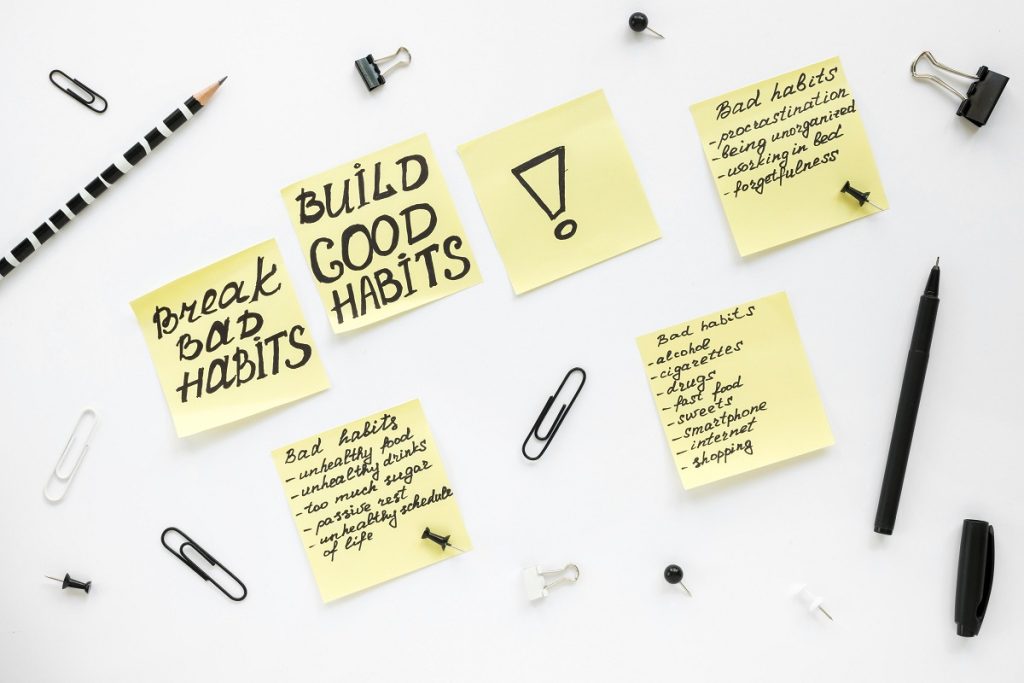
What Are The Benefits Of Using Cue Cards?
Cue cards are an effective way to organize information and create prompts to ensure a speech goes smoothly. That’s not the only benefit of using cue cards, however.
Among the additional advantages of using cue cards are.”
- Helping to keep you focused and on track during presentations or speeches.
- Ensuring you remember all essential points.
- Making eye contact and audience engagement easier . By having a clear and concise outline of your presentation or prompts, you can maintain better eye contact with the audience, which helps to build rapport and keep the audience engaged.
- Reducing anxiety and nervousness when speaking in front of an audience. Having key points written down makes it easier to feel confident in your ability to deliver information and avoid stumbling.
- As a reference tool for future presentations or speeches. By keeping cue cards organized and accessible, you can refer back to them whenever needed, saving time and effort in preparing for future events.
Are Cue Cards Still Used?
Cue cards have been a visual aid staple of public speaking for decades. They’ve been used by politicians, actors, and anyone who needs to deliver a speech or presentation.
However, with the rise of technology and the availability of teleprompters, cue cards have often taken a backseat.
But the answer is yes; cue cards are still used in certain situations. Teleprompters may have become more prevalent in recent years, but cue cards still have their place.
Improv shows and late-night TV are areas where handwritten cue cards are still used regularly. Shows l ike Saturday Night Live (SNL) have teams like the one led by Wally Feresten dedicated to creating handwritten cur cards to help facilitate the performances.
The cue cards for the iconic “Live From New York” show are revered by the show’s performers – so much so that Seth Meyers, known for his Weekend Update bits, has his final cue card framed and hanging in his home .
Cue cards offer a level of flexibility that teleprompters can’t match . For example, cue cards can be easily adjusted on the fly if there is a technical issue with the teleprompter or if the speaker wants to make an impromptu change to their speech.
Additionally, cue cards give presenters flexibility and the ability to maintain eye contact with their audience while delivering their speech. This helps to build rapport and engage listeners.
What Is The Difference Between Cue Cards And Flashcards?
Cue cards and flashcards are both commonly used study aids, but they serve different purposes.
Cue cards, or note cards, provide a speaker with a brief outline or critical points of a speech or presentation. They’re designed to be used as a memory prompt, helping the speaker to deliver their message more effectively.
Cue cards are also typically larger and contain fewer details than flashcards. They’re generally used in public speaking or oral presentations to help the speaker stay on track and remember key points.
On the other hand, Flashcards are used primarily for memorization and recall. They’re small cards, typically index cards, that contain information on both sides and are intended for study aids to memorize facts, concepts, or vocabulary.
Flashcards are often used for test preparation and other academic settings. They’re generally handwritten, portable, and a great way to practice active recall, which is the process of trying to retrieve information from memory.
The major difference between cue cards and flashcards is their purpose.
Cue cards are used as a memory prompt for a speaker, whereas flashcards are used for memorization and recall purposes.

Are Their Downsides To Using Cue Cards?
Although cue cards can be helpful, there are downsides if you become too reliant on them. For instance, reading directly from the cue cards can cause your speech to sound canned and too speechy.
There are things you can do, however, to prevent cue cards from being a problem.
The following public speaking tips for using cue cards as part of your speech can help you deliver your presentation successfully:
- Keep the cue cards simple and easy to read . This means using large font sizes and avoiding cluttered layouts. Additionally, bullet points or short phrases rather than complete sentences are advisable.
- Practice! Using cue cards effectively requires a lot of practice before the actual speech. Familiarizing yourself with the content will reduce the need to constantly refer to the cards during the speech. Reading your speech off cue cards word for word will prevent your audience from connecting with you.
- Place the cue cards at the appropriate spot . This may mean holding them at a proper distance and angle from your face. If a camera’s involved, ensure the cue cards are just to the side of the camera and flipped as needed.
- Be sure to maintain eye contact with the audience as much as possible while referring to the cue cards when needed. This will help keep their attention on the speaker rather than the cards.
By following these tips, cue cards can be a helpful aid in public speaking without becoming a distraction.
How Can They Be Useful For Remote Meetings, Interviews, And Presentations?
In remote meetings, cue cards can be especially useful as they help keep the discussion focused and on topic . They also ensure that all participants have access to the same information, making it easier for everyone to follow along.

During interviews, cue cards can remind the interviewee of key points they want to make or questions they want to ask. This helps them stay calm and composed while ensuring they don’t forget anything important.
Lorin Harrott
After years as a professional speaker and corporate trainer,Lorin Harrott has turned her attention to sharing her knowledge through writing. She's currently a writer, photographer, and mom in Sacramento, CA, with occasional speaking engagements related to education and STEM topics in the public school system.
Recent Posts
Active Listening Absorbs The Whole Message, Not Just The Words
Active listening goes beyond hearing the words someone is saying to you and understanding the message they are conveying. Many only hear a small percentage of what is being said as they are...
Counteracting Fear Of Public Speaking With Coaching And Therapy
Nearly 75% of people experience the social phobia of fear of public speaking. The result may be nervousness before speaking or a full-blown panic attack. Practicing public speaking may lessen the...
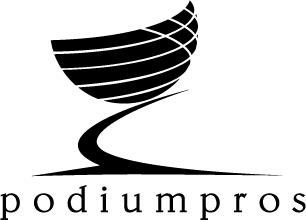
CALL 1-855-739-6745
- April 12, 2023
- Podium Pros

5 Ways to Effectively Use Note Cards During a Presentation
Presentations can be a great way to showcase your knowledge and understanding of a particular topic. However, presenting in front of an audience can be intimidating for many people. Fortunately, public speaking can be made easier with the use of note cards. Note cards offer a great way to ensure that you cover all the points you want to make during your presentation and also provide a physical reminder when it comes time for delivery. Here are five ways to effectively use note cards during a public speaking engagement like a conference or event.
1: Outline Your Thoughts and Ideas
The first step in using note cards effectively is to utilize them as a way to organize your thoughts and ideas. Start by writing out the main points you want to cover during your presentation on individual cards, along with any key facts or figures that need to be included. This will help you keep track of what needs to be said and when allowing you to stay on track during your presentation.
2: Use Visual Aids
Note cards are also a great way to include visual aids in your presentation. If you have charts, graphs, or pictures that need to be included, jot down the key points on the back of the note card so you can reference them during your talk. This will help ensure that all relevant information is covered without having to search for it during the presentation.
3: Rehearse
Once you have your cards organized, it is important to practice your presentation. This will help you become familiar with the material and also get comfortable speaking in public. Use the note cards as a guide during your rehearsal so that you can ensure all points are covered and presented in the proper order. Make sure to pay attention to your vocal inflections and body language during rehearsal, as these will be important when presenting in public.
4: Highlight Key Points
When presenting, it is important to emphasize key points so they are easily remembered by the audience. Use colored markers or tabs to highlight these points on your note cards. This will help you keep track of what needs to be emphasized and make sure that all key information is included in your presentation.
5: Use A Lectern
Finally, it is important to use a lectern when presenting. This will help ensure that you have easy access to your note cards and also provide a stable surface for them to rest on as you speak. Additionally, having the lectern in front of you can help boost your confidence and reduce any public speaking jitters you may have.
By following these tips, public speaking can become much easier and more enjoyable. With the help of note cards, you can ensure that all relevant information is included in your presentation and keep track of what needs to be said. So don’t be afraid to take the lectern and give a great presentation!
Custom Lecterns by Podium Pros: Take Your Presentation to the Next Level
At Podium Pros, we specialize in delivering custom lecterns for any kind of event whether it be for a school, business, or religious organization. Our lecterns are designed to not only look great but also provide an enhanced level of comfort and stability while presenting. Podium Pros will work with you to design the perfect lectern for your needs and make sure that it is delivered on time for your event. Contact Podium Pros today to learn more about our services and how we help take your presentation to the next level.
Choose Podium Pros as your trusted source for high quality, customized, speaking lecterns.

1 Year Manufacturer Warranty

Customization and Branding

Proudly Made in Canada

Exceptional Customer Service

GET SOCIAL WITH US
Head office.
353 Saunders Rd. Unit 10, Barrie, ON. L4N 9A3 Canada
REVIEW US ON GOOGLE »

BUSINESS HOURS
Monday – Friday 8:00am – 5:00pm
SUPPORTED PAYMENT METHODS

© 2024 Podium Pros. All rights reserved. PRIVACY POLICY
Choose the Pros
Let us help you pick the right lectern for your needs.
How to Make and Use Note Cards in a Presentation
- Armani Talks
- July 3, 2022
- public-speaking
You have a speech coming up.
And you’re pretty nervous about what to expect.
One of the nervous thoughts is:
‘What if I forget a crucial point?’
In this article, I’m going to be a little unorthodox.
- First, I am going to insult note cards.
- Then, I’m going to share how to use note cards effectively in your speech.
Why the oxymoron?
You’ll see as the article progresses…
The Power of Your Memory
Nowadays, we have forgotten how powerful our mind is.
There are so many software and gadgets out there, that our memory doesn’t get the exercise that it deserves.
So, what happens?
We think we will forget something very quickly.
This perception wouldn’t be the case if we exercised our memory.
Where we actively try to remember something.
You’ll be surprised by how much information you can store.
But I get it, we are all in different stages.
You may be like:
‘Sure Armani, I believe you. My memory is powerful. But I still feel more confident having some notecards by my side.’
Sounds good, bud.
I’ll share how to use note cards for the rest of the talk.
But do one thing for me. Ask yourself:
‘If the notecards were to be set on fire RIGHT before I walk on stage, will I still be good?’
This is a profound question.
This question allows you to view the note cards as a servant rather than a master!
Prepare like that.
This will allow you to:
- Know your speech rather than just parroting the words in a sequential fashion.
- Add only relevant points to your notecards.
How to Create Note Cards in a Presentation
Note cards are typically built on index cards.
The sizes vary.
But a standard size for a presentation is 3×5 .
Once you have the cards, identify the main points of the speech.
‘How do I know what my main points are?’
Fam, if you don’t know what the main points are then you need to practice some more!
Here’s my rule for practicing a speech:
Go by the 5x rule.
The 5x rule is when you aim to get through the speech 5 times to perfection.
Anytime you mess up, start back over.
It doesn’t matter if you are in the last 5 seconds of your talk…
If you feel as though you fumbled, start over.
Once you get through the talk 5 times, the speech will be in your subconscious mind.
By the way, getting through your speech 5 times to perfection does not mean you recite it verbatim each time.
Instead, you go through the main points in a rhythm that allows you to feel comfortable.
After your 3rd attempt, you’ll have a firm grasp on what the main points are.
If you are still unsure of what the main points are…
Then imagine I put a gun to your head and say:
‘Explain your entire speech in 20 seconds. If you don’t, then I’ll pull the trigger.
This will allow you to separate the signal from the noise much faster.
The main points can now be given real estate on your note cards.

Adding in Details
Once you have the main points, you want to ask yourself:
Are there any details that I should be aware of?
These details are normally:
- Statistics.
- Important dates.
- Particular numbers.
- Important names.
By spotting which details are important, you can create a subpoint under the main point from the last section.
Avoid writing paragraphs or bulky sentences.
Keep the card lean.
Your future self on speech day will thank you.
If your speech cards are too bulky, then you will lose faith in yourself.
When you lose faith in yourself during public speaking, then you just read off the cards.
Keep it simple.
A sample point is:
- Subpoint : First football game played: November 6th, 1869 (important detail).
Lean, mean, public speaking machine.
Highlighter Trick for Note Cards in a Presentation
Sometimes, you may get through a few points on your card and be like:
‘Hm…. Which point am I on again?
In order to circumnavigate this, leverage colors.
Humans process information seamlessly with colors.
Color each major point a different color with your highlighter.
Point 1: Orange.
Point 2: Yellow.
And Point 3: Purple.
This allows your eyes to automatically gravitate towards a certain point, rather than standing on stage scanning the card like a dummy.
Final Words on Using Note Cards in a Presentation
Once again, I would encourage you to lead with memory.
‘If these cards were destroyed, can I still deliver my talk?’
Answer this question honestly.
Your mind is a muscle.
And it can be worked out for life.
Understand this.
Once you have answered the question honestly, keep polishing up the cards.
Aim to keep it lean.
Simple words which invoke a memory beat paragraphs upon paragraphs.
Public speaking is a mental sport.
You get better with practice.
View your index cards as training wheels.
One day, the training wheels will come off.

Book to Improve Public Speaking
If you enjoyed this article and want more practical tips on public speaking, then be sure to check out:
- Speaking Wizard: The Magical World of Public Speaking
This book will walk you through A-Z of presentation skills.
You’ll learn the art of turning speech anxiety into speech excitement.
Notice…we aren’t trying to kill the nerves.
We are simply trying to alter our perception in regards to it!
You’ll learn how to design a speech fast .
No more overthinking and second-guessing.
You’ll learn how to practice your speech to perfection.
No more aimless words and droning on.
Each rep in your practice session will come to life with added efficiency.
You’ll learn what to eat on the day of the speech.
What to wear…
And you’ll get a bonus chapter on Toastmasters!
A lot of topics.
Get the Speaking Wizard and level up your public speaking game!

– ArmaniTalks
Join the armanitalks newsletter, level up mentality : a guide to re-engineer your mindset for confidence.
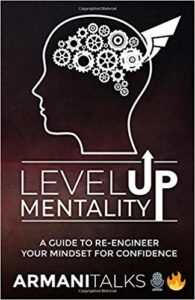
BUY ON AMAZON

Leave a Reply Cancel reply
Your email address will not be published. Required fields are marked *
Save my name, email, and website in this browser for the next time I comment.

Join the ArmaniTalks 🎙️🔥 Newsletter
Download free.
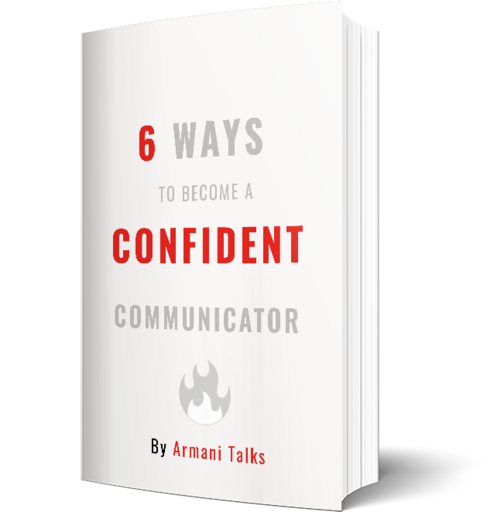
Privacy Overview

55 Speaking Notes and Practice: Reminders and Additional Tips
Learning Objectives
Use notes wisely and effectively
- Create effective notecards that enhance your speech delivery.
- Rehearse your speech for an extemporaneous delivery.
Preparing for Your Speech Delivery
As we have learned, speech making is a process of sequential steps that will help us to deliver an effective speech. We are now at our final speech preparation steps – again! Below are some reminders as well as additional tips to help you finish your preparation for a successful speech delivery!
Preparing Notes
Once you have created a comprehensive outline and have thought through your speech, you should be able to create your note cards or whatever you might be using (notes or an iPad for instance). Every speaker is a bit different, and different speech topics and organizational patterns may require different notation techniques.
Tips for creating and using your note cards
Your note cards (or cue sheets) must have enough information on them to be able to deliver the speech without missing details; they should be organized in the precise order that you have planned. When you are finalizing your speech making process and putting the finishing touches on your outline, you are ready to make the notecards. DO NOT make note cards before you are done with your speech making process. Your note cards should only contain a few words that will guide your speech. You will read your outline word-for-word if you use an outline; so, it is essential for you to spend time on creating note cards. Once you have created effective note cards, you will want to practice with your visual aid, your note cards, and any other props you have to ensure a strong delivery.
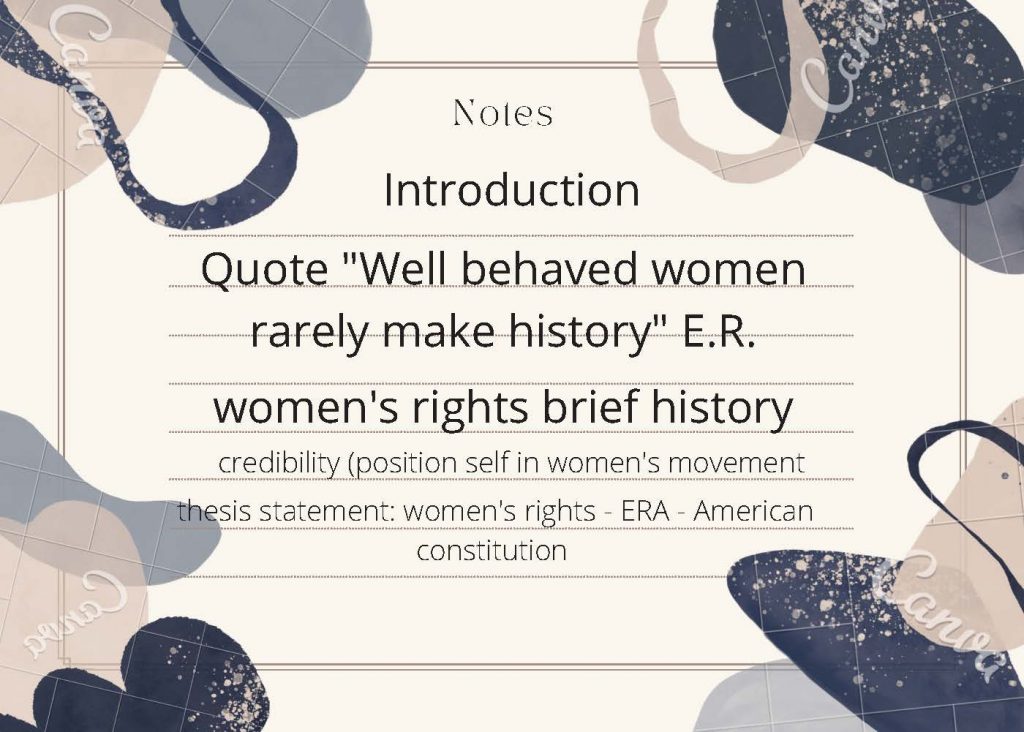
During the delivery:
- You should be able to glance at the cards, get your bearings, and look back at the audience. If you are reading the cards word-for-word, there are too many words on them, unless it is an extended exact quote, or group of statistics that must be delivered precisely.
- Be sure your notes or cards are numbered (e.g., boldly in the upper right hand corner), so you can keep them organized. Color-coding is often done to easily distinguish the cards at a glance. Losing your place can be very stressful to you and distracting to the audience.
- Avoid writing or printing on two sides; flipping a page or card is distracting to the audience. The audience should not be aware of the notes. It is best to simply slide the cards aside to advance to the next card.
- Rehearse your speech using the notes that you will bring to the podium. Be sure you can glance at the notes, get your information, and look up to have eye contact with the audience.
Watch this quick Youtube video to learn how to use notes effectively in a speech. There are great ideas to overcome bad habits and engage in “good” note card use.
Rehearsing the Speech
Students under estimate the amount of time the goes into outlining, creating note cards, and rehearsing their speeches. This “tying up loose ends” is essential for a strong speech delivery. Here are a few tips to remember before you deliver your speech.
Rehearse your speech – aloud and ideally with a colleague or fellow student as an audience
- Rehearse in front of a mirror if needed.
- Think of doing a quick SWOT analysis. What strengths are present? What weaknesses are present? What opportunities for improvement do you have? What threats exist?
- Practice as if you are LIVE. Use the same technology, presentation aids, notecards and/or tangible props.
- Use a timer – consider writing the time on your note cards to keep yourself on track with the pace of your speech.
- Create a practice timeline that will allow plenty of revision time, editing of your outline, and updating your note cards for delivery. Be sure to implement feedback in order to strengthen your argument.
You should also know exactly how your speech will begin and end. Regardless of how dependent on notes the speaker may be, here is one constant word of advice: know exactly how you are going to begin your speech. Not just an idea, but verbatim, with every inflection, every gesture, every eye contact with the audience. The first few sentences should be so ingrained, that you could perform it during an earthquake without batting an eye.
A memorized introduction accomplishes several goals. First, it gives you the opportunity to breathe, and realize it’s not so bad to be up there after all! Second, it lets the audience know you are prepared. Third, it signals to the audience that what you are about to say is important. Finally, it gives you the opportunity for direct eye contact (because you are not reading) and commands the audience’s attention. Eye contact is a signal to the audience that you care about them!
The conclusion of your speech is equally important. In show business parlance, the end of a song or a scene is called a “button.” It is a “TAH-DAH” moment that lets the audience know you are finished, and that it is their turn to applaud. The ending impression your speech leaves with the audience is greatly affected by how effective the ending is. The content and structure notwithstanding, you should also know exactly how you will end (verbatim), so there is no hesitation, no stumbling, no tentative “I guess that’s all” feeling. A confident and decisive beginning will draw the audience to you; a confident logical ending will be very effective in preserving a lasting impression on the audience.
One of the key elements to an effective speech is our delivery method. We are presenting speeches, not reading them . Our goal is to deliver our speeches extemporaneously.
Extemporaneous speaking is one of the most natural methods for delivering a prepared speech. You can use an extemporaneous speech to achieve a more natural tone, flow, and style with the audience. This requires extensive preparation and practice.
| Figure 12.1: Rehearsal Checklist |
|---|
To prepare for an extemporaneous speech, you must understand the difference between your preparation outline and speaking notes.
- Your preparation outline helps you to get prepared for your speech by providing the opportunity to organize and write your ideas in a speech format. This is your “formal” outline you use to organize your ideas (it is also the outline you turn in to me).
- Your speaking notes help you achieve a conversational and natural speech delivery.
See these tips for creating speaking notes:
https://www.wikihow.com/Prepare-Notes-for-Public-Speaking
Another Guide to Preparing Speech Notes
Speaking notes have an advantage over preparation outlines. For example, you can easily look at your notes for reference and as a personal reminder of which topics to discuss as you’re speaking.
Speaking notes commonly take two forms: alphanumeric and decimal.
An alphanumeric outline includes a capitalized number or letter at the beginning of each topic. Look at the sample:
Thesis statement: E-mail and internet monitoring is an invasion of employees’ rights
I. The situation: Over 80% of today’s companies monitor their employees.
….A. To prevent fraudulent activities, theft, and other workplace related violations.
….B. To more efficiently monitor employee productivity.
II. What are employees’ privacy rights when it comes to electronic monitoring and surveillance?
….A. American employees have basically no legal protection from mean and snooping bosses.
……..1. There are no federal or State laws protecting employees.
……..2. Employees may assert privacy protection for their own personal effects.
….B. Most managers believe that there is no right to privacy in the workplace.
……..1. Workplace communications should be about work; anything else is a misuse of company equipment and company time.
……..2. Employers have a right to prevent misuse by monitoring employee communication.
Decimal outline
The decimal outline shows how each item at every level relates to the whole sample.
Thesis statement:
1.0 Introduction
….1.1 Brief history of Liz Claiborne
….1.2 Corporate environment
2.0 Career opportunities
….2.1 Operations management
……..2.1.1 Traffic
……..2.1.2 International trade and corporate customs
……..2.1.3 Distribution
….2.2 Product development
You will note that in both examples, only keywords are used. You can handwrite or type your notes on either a sheet of paper or note cards. The important point is that you do not have a word for word speech – you only have reminders on your key points. This seemingly small difference helps you to have a natural and conversational delivery.
Practice and Rehearsal Guidelines
The following guidelines are best practices on how to practice and rehearse an extemporaneous speech:
- Speak in a conversational style by pretending you are with your audience.
- Rehearse with your graphics and coordinate them with your talk.
- Display your graphics only when you are talking about them.
- Rehearse in front of others and solicit feedback.
- Record and listen to your timed practice speech.
- Prepare for interruptions and questions at the end.
Extemporaneous speaking is not memorization and manuscript speaking and requires you to organize and prepare your content and notes ahead of time to deliver a speech that will engage your audience.
Key Takeaways
Deliver your persuasive speech with note cards, a visual aid, and strong body language.
- The use of note cards is essential to public speaking.
- Public speaking students overlook the importance of note cards and visual aids to enhance their delivery; when used effectively, note cards can greatly increase a students effectiveness.
- To ensure a smooth delivery, practice with plenty of time to make any changes to your delivery notes and method of audience connection.
Victor Capecce, M.F.A.. Provided by : Millersville University, Millersville, PA. Located at : http://publicspeakingproject.org/psvirtualtext.html . Project : The Public Speaking Project. License : CC BY-NC-ND: Attribution-NonCommercial-NoDerivatives
Public Speaking Copyright © by Dr. Layne Goodman; Amber Green, M.A.; and Various is licensed under a Creative Commons Attribution-NonCommercial-ShareAlike 4.0 International License , except where otherwise noted.
Share This Book
- Speech Writing
- Delivery Techniques
- PowerPoint & Visuals
- Speaker Habits
- Speaker Resources
Speech Critiques
- Book Reviews
- Browse Articles
- ALL Articles
- Learn About Us
- About Six Minutes
- Meet Our Authors
- Write for Us
- Advertise With Us
How to Use Notes in a Speech: A Guide for Speakers
Only one of the following statements is true. Do you know which one?
- You should never use notes because you will look unprepared.
- You should always use notes because memorization weakens your delivery.
- You should never use slide text as notes.
In this article, we identify scenarios where a full script is warranted or where memorization is advisable. For all your speaking scenarios in the middle, we discuss 21 tips for using notes effectively .
Full Script, Notes, or Nothing at all?
A previous Six Minutes article ( how to read a speech ) identified several speaking scenarios where reading a full script may be required or preferred :
You are speaking at a highly formal occasion (e.g. a commencement speech) You are delivering a particularly emotional speech (e.g. a wedding speech, a eulogy) You are forced to read word-for-word by lawyers or campaign managers (e.g. a corporate statement; a political speech) A speechwriter has written your speech. Life prevented you from preparing adequately. (Don’t let this happen often… your speech really would go better if you prepare.) You are a brand new speaker, and you haven’t developed the confidence yet to go without a script.
Likewise, there are speaking scenarios where it is highly desirable to avoid any notes and memorize your speech instead:
- You are giving a TED talk (or speaking at a similar “ballroom” event) where you’ve got twenty minutes or less. These events set a high bar for preparation.
- You are pitching to investors, potential customers, potential employers, or any type of career-shaping presentation . I would include many academic and industry conferences in this group, although some may have a less rigorous culture.
- You are offering a short toast .
- You are completing a course speech assignment, and you are not allowed to have notes.
- Your speech is so short (~ six minutes or less) that you ought to be able to deliver without notes.
If we eliminate those two extremes (full script and no notes at all), we are left with a majority of speaking scenarios where using notes is perfectly acceptable . These include:
- You are teaching a course, which is several hours or days in length.
- You are delivering a keynote address or some other lengthy speech at a conference.
- You are delivering a lunch-time seminar.
- You are addressing a service club or community group.
- You are delivering a webinar.
- You are doing a routine presentation at your workplace.
- Any other scenario where your speech is too long to memorize, but not formal enough to demand a full script .
If you are ever concerned about the culture and expectations for an event at which you are speaking, consult with the organizers. If this isn’t possible, err on the side of caution and be prepared to present either without notes or with absolute minimal notes.
Tips for Using Notes Effectively
If you decide to use notes for your presentation, you still have several choices to make. What medium do you choose? Can you use slide bullets for notes? Does it matter how your notes are formatted? What messages can you pass yourself within the notes? How do you deliver with notes in a way that doesn’t hamper your impact?
Choose the medium that suits your style.
“ The purpose of notes is to jog your memory, not provide lengthy passages to read. ”
- Use a classic: index cards. Many speakers–from elementary school students to career professionals–swear by index cards. If this is what you like, invest in a good hole punch and link all the cards together with a metal ring. This prevents the disastrous “Oh my! My cards are out-of-order” phenomenon.
- Go big (or at least letter-sized). Some people prefer using legal pads or standard letter-sized paper. The main advantage is that you can fit more on a page, so you won’t need to flip pages very often. For many presentations, a single one-sided page is all you’ll need. [This is my personal preference.]
- Go little: sticky notes. I’ve seen a couple professional trainers work from a large cardboard “palette” covered with many little colored sticky notes, each with a word or phrase. As each topic was covered, the trainer adeptly moved the corresponding note to the “done” pile to keep track of what they had covered. This allows a highly adaptive presentation style where you can cover content in an audience-driven order or not-at-all.
- Go digital with a tablet. There are countless note-taking or outline apps that can do the job for you. Some people love that it’s paper-less; others worry about the device staying charged long enough to be useful. Having to “swipe” your device back on from a black screen every time you need to consult your notes could be annoying, for you and your audience.
- Use presentation software… but do it properly. If you are presenting visuals, then the notes feature of your presentation software (e.g. PowerPoint) can be used in two distinct ways. In the first method, you can print out a set of “notes pages” which combine the slide content with your notes content. In the second method, you can use “Presenter View” to display your slides for the audience and, simultaneously, your slides and notes for you. For a well-rehearsed speaker, this can work very well. (Don’t show up at the event expecting to learn it on the fly!) Finally, do not ever use text on slides themselves as your notes. Audiences universally hate this.
Design your notes for easy consumption.
“ Do not ever use text on slides themselves as your notes. Audiences universally hate this. ”
- Minimize the words. Remember that the purpose of notes is to jog your memory, not provide lengthy passages to read. Don’t use sentences; use keywords or phrases instead. For example, you might distill an entire talk into short notes like “crutch metaphor”, “dentist story”, or “personnel strategy”. Verbose notes leads to two equally bad outcomes: [1] lots of reading, and [2] a high likelihood that you’ll get lost in your notes.
- Maximize scan-ability. Regardless of which medium you choose, be sure to type or print as neatly as possible. The last thing you need to do during your presentation is to decipher a messy or handwritten notes page. Use the largest font you can, and plenty of white space.
- Format wisely to provide clues. Used strategically, formatting such as bold, italics, underline, and color or size variations allows you to convey meaning to your future self.
- Adjust with colored pens or highlighters. Let’s say you’ve got a nicely printed notes page, but while rehearsing you realize that it’s missing a few words or some emphasis. A little touch-up with a colored pen or highlighter will fix it. Avoid using light pencils as it can be hard to read and it is prone to smudge.
- Use meaningful layout. Mirror your speech outline in the notes. Assuming you’ve distilled each point (paragraph), anecdote, or story down to a few words, these can still be displayed in a hierarchy that mirrors your speech outline.
- Organize in whatever style works for you. Don’t be afraid to use any organization scheme that works for you. One of my speaking mentors sometimes uses a single-page mind map as her “notes” page. I don’t think this method would work for me, but it worked wonderfully for her. Experiment!
Use notes for strategic purposes.
- Use notes for other people’s words. You can memorize quotations or a short excerpt of another work (e.g. a poem, story, or news article). However, there’s virtually no down side to reading it from your notes instead. An added bonus is that it signifies the respect you have for the other author.
- Aim for precision. Similarly, facts, statistics, and definitions can be memorized (and definitely should be if they are used in your speech opening), but it’s often safer to just put them in your notes. Reading a statistic from a note (as opposed to memorizing it) signals that you value truth and precision over appearing polished and “smart”.
- Remind yourself to interact with audience. In the past, I was prone to forgetting things like polling the audience, or doing a brainstorm exercise on a flip chart. (I think these items are easy to forget because they are always skipped during rehearsal.) So, I developed a habit of inserting clues like “[POLL AUDIENCE!!!]” or “[FLIP CHART]” in my notes to remind me.
- Remind yourself about timing or logistics. When I teach courses that last several hours, my lesson plan includes a rough timing breakdown which tells me that I should complete the first section in twenty minutes, or complete the group exercise by the ninety minute mark, and so on. I insert these timing reminders right into my notes, and I do the same for other logistical reminders such as “[STRETCH BREAK]” or “[DISTRIBUTE 2nd HANDOUT]”.
- Spell unfamiliar words phonetically to aid pronunciation. In a 1963 speech from Berlin, U.S. President John F. Kennedy uttered the famous phrase “ Ich bin ein Berliner ” (I am a Berliner). President Kennedy desired to pronounce this phrase correctly, so he wrote the words out phonetically: “ Ish bin ein Bearleener ” (his handwriting is shown in the photograph below). Though I don’t recommend handwriting today, I’ve often used this trick as a Master of Ceremonies to avoid pronunciation mistakes when introducing other speakers.
Handwriting of President John F. Kennedy to indicate the correct pronunciation of several speech phrases.
Deliver with confidence.
- Don’t apologize for having notes. It’s okay to have notes. Really! I cringe whenever a speaker apologizes for “needing” notes… not because the apology is so tragic, but rather because it usually signifies a lack of confidence. Prepare and deliver to the best of your ability, and skip the apologies.
- Practice with your notes, and revise as necessary. Just as with visuals, props, or anything else you intend on having with you during your presentation, rehearse with your notes. As you practice, add keywords to your notes if there’s a point, a story, a transition, or anything else you tend to forget. If you’ve never used “Presenter Mode” with slides before, then practice!! I’ve seen dozens of people launch into this mode without any prior preparation, and it usually kills a few minutes pointlessly.
- Glance at your notes at natural breaks. When you are speaking, try to keep your eyes up on your audience. Take advantage of natural pauses to refer briefly to your notes. For example, when I teach courses, I tend to glance down just after I change the slide. At that moment, the audience will direct their attention to the new slide, so this is a perfect opportunity. Once you’ve finished, bring your head back up and begin speaking again.
- Avoid glancing at your notes at critical moments. Your opening, closing, and any other “core moment” should be delivered with confidence, and glancing at your notes at this time will detract.
- Put your notes down… if there’s a place to put them. If you carry your notes around, it can be a visual or auditory distraction. Also, if you’ve got anything in your hands for a long period of time, it tends to limit natural gestures. If there’s a lectern, table, or any convenient surface, that will work. But if there is literally no where to put the notes, then just hold your notes in your hand. (Don’t put them on the floor. Bending down repeatedly will lead to awkward moments that are best avoided.)
Put in into Practice
Think about the next presentation you are scheduled to deliver.
- Are notes appropriate for this setting?
- How can you improve the content of your notes?
- Do you have quotations, facts, or other content that can go into notes to lessen your cognitive burden?
- Is today the day you will learn how to use Presenter Mode in your presentation software?
Please share this...
This is one of many public speaking articles featured on Six Minutes . Subscribe to Six Minutes for free to receive future articles.
Add a Comment Cancel reply
E-Mail (hidden)

Subscribe - It's Free!
| Follow Us |
Similar Articles You May Like...
- Never Read Your Speech… Never?
- How to Make Reading a Speech Not Like Reading a Speech
- The 7 Deadly Sins of Public Speaking
- 10 Presentation Bad Habits My College Students – And You – Must UN-Learn (Part 2)
- Speech Critique: Suki Kim (TED 2015)
- How to be a Confident Speaker with a Speech Disorder
Find More Articles Tagged:
Recent tweets.
Was talking to a client this afternoon about using notes when #presenting. Here is another great article from… https://t.co/M6Coa1JM6i — Mel Sherwood – Pitch & Presentation Specialist (@MelSherwood_) Dec 7th, 2018
How to Use Notes in a Speech: A Guide for Speakers https://t.co/la3tPHC7vG by @6minutes #nsa19 — Joel Heffner ✍🏼 (@JoelHeffner) Feb 12th, 2019
Featured Articles
- Majora Carter (TED, 2006) Energy, Passion, Speaking Rate
- Hans Rosling (TED, 2006) 6 Techniques to Present Data
- J.A. Gamache (Toastmasters, 2007) Gestures, Prop, Writing
- Steve Jobs (Stanford, 2005) Figures of speech, rule of three
- Al Gore (TED, 2006) Humor, audience interaction
- Dick Hardt (OSCON, 2005) Lessig Method of Presentation
Books We Recommend
| [ ] | [ ] | [ ] |
| [ ] | [ ] | [ ] |
| [ ] | [ ] | [ ] |
| Follow Six Minutes |
Six Minutes Copyright © 2007-2019 All Rights Reserved.
Read our permissions policy , privacy policy , or disclosure policy .
Comments? Questions? Contact us .

How to Make Cue Cards

How to Structure a Presentation
Cue cards or flashcards are a memory device used in test preparation, acting auditions and oral presentations. They can be a speaker's best friend, but they must be used properly to be effective. Simple techniques are used so information on the cards can catch the speaker's eye at just the right moment to cue memory. Once the cards are created, the speaker should use them to rehearse and revise and edit the cards as needed.
Use Short Bullets
Create cue cards to be short bullets of information. Each card should contain one main idea and keywords as a guide for that specific section of the speech. Avoid writing full sentences, because these are difficult to read while presenting and may cause more confusion when a speaker is nervous. Susan Dugdale, a veteran speaker and speechwriter, explains that a clear presentation also requires eye contact with the audience for a smooth delivery. Writing cure cards with bullets will keep the orator from reading his entire speech.
Color Code Topics
Categorize the cue cards and their information by using particular colors for each topic. Highlight each section of the speech in one color. This will help the speaker's eyes note transitions, and when cues cards are used during rehearsals, the colors become additional memory prompts. Use a bright color to highlight key points and facts that are difficult to remember. This ensures the speaker won't skip them if she feels nervous or rushed.
Include Cues to Guide the Speech
Add cues to the cards that will not be spoken but will assist with the overall presentation. For example, placing a card number in the same location on every card can help a speaker maintain a pace during the speech and will keep the speech note cards organized. Other cues such as "eye contact" and "breathe" return the speaker's attention to the audience when he might be tempted to speed up and just read from the cards. If the presentation has a time limit, it can help to include time estimates on two or three cue cards throughout the set. This keeps a speaker on pace to finish in the allotted time.
Aim for Clarity and Readability
Design and write cards to be easily read at a glance. This is done with neat handwriting in a font size that is larger than normal. Use the white space of a card to guide the eyes to the most important information. Use a “less is more” approach. A card that is cluttered or difficult to read will not be effective and may increase the speaker's anxiety if the facts are hard to find. If the presentation requires the use of visual aids, include prompts on the cards to cue when to display them or draw the audience's attention to them. While it might be tempting to type the cue cards in order to enhance legibility, writing the cards neatly by hand provide the added benefit of improving memory.
Use Transitions to Anticipate Upcoming Information
Place transitional statements at the bottom of the card that foreshadow the information to come. On the last card for each topic, for example, write a brief transitional statement at the bottom that previews what the next topic will be. Motivational speaker Nick Skellon uses this simple tactic to make his speech delivery smoother. By giving himself a hint about the information on the next card, he can start speaking, while making eye contact, as he flips his cards. He suggests using only one side of each cue card.
Practice with Cue Cards
Whether preparing for a test, an audition or an oral presentation, using the cue cards to practice the material is beneficial because it can help identify areas that need improvement. Rehearsing the information with cue cards also helps identify the right pace to strive for and can further aid memorization of the material.
Related Articles

Difference Between a Speech & a Lecture
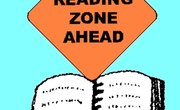
How to Teach Reading

Four Methods for Delivering Oral Presentations

The Disadvantages of Audiovisual Aids in Teaching

How to Do a Paper Review Presentation

How to Use a Summarization for APA Format

How to Write a 3-Minute Speech Fast

How to Give a Dedication Speech
- Write Out Loud: Cue Cards -- How to Make and Use Them Effectively
Michael Green graduated from one of the top journalism schools in the country, the University of Missouri, where he also received his master's degree in education. Green has taught creative writing, journalism and health and has been published in "Body Balance," "Alive" and "PUSH Monthly."

Create effective cue cards
Having well-organized cue cards gives you added security when you take the stage. However, if you keep your eyes glued to your cue cards, you may neglect to inject gestures and facial expressions into your presentation. Follow these tips to write cue cards that aid—not hamper—your speech:
- Don’t write out your entire speech. Include an outline and word prompts to jog your memory—don’t jot down every word.
- Write in short phrases. Use only a few words per line so that you can quickly glance at the cards and continue speaking.
- Write big. Make your cues easy to see with large print.
- Use one topic per card. That will allow you to easily organize your thoughts and skip over topics if you are running short on time.
- Number your cards to keep them in the right order.
- Cue visual aid usage. Write on the cards where you plan to use visuals.
—Adapted from “Cue Cards: How to Make and Use Them Effectively,” Susan Dugdale, www.write-out-loud.com.
WHAT TO READ NEXT

How to Prepare Note Cards for a Speech

Instructions
At first, add necessary points to the note cards and also write number on the left corner like one, two, three etc, in order to keep them in a proper sequence.
The numbering on note cards will help you to re-arrange them if you ever lose their sequence.
You should write “Introduction” at the top of your first note card and also include the necessary contents in it which will enable you to deliver the introduction effectively.
Now place number two in the next note card and also write “Body or Details” and include all necessary points you want to include in the details of the subject.
On the subsequent card, which is number three, write “Supporting Points” which will help you to support your view point with examples etc.
You should write “Conclusion” on your final card and summarise all of your points that you want to convey in your overall speech.
You can also highlight major points on these note cards if these points are important and you want to focus on them during your speech.
- Print Article

People Who Read This Also Read:

Your hands are sweaty. Your legs feel shaky. You're light-headed. Now step up to the lectern and give your speech. Because you prepared ahead of time by creating well-formatted, informative speech note cards, you can overcome these jitters and deliver your speech, knowing you won't forget any of the important information you need to cover. Creating note cards is one of the most comforting preparation steps you can do before giving a speech, whether in front of strangers or your peers.
Number your note cards. If you accidentally drop your cards or get them out of order while shuffling them, having them numbered helps you get them back into order quickly.
Type or hand-write the information on each card. Use a larger font -- 14 or 16 point -- if you are printing the information on the cards. Print a sample card or two to check the font size, making sure you can easily see the printing from the distance between the lectern and your eyes when you are standing up.
Double-space the information on the cards. Writing on every line makes it difficult for your eyes to locate the information you need. Use a bold font or highlight the important points you must cover on each card. Focus on writing keywords rather than complete sentences. However, if you are incorporating a quote or poem into your speech, write it in its entirety so you don't forget it.
Place reminders to yourself on the cards, such as "pause here" or "point to visual now."
Practice your speech. Use your cards as you go through the speech so you'll know whether everything you need to cover is recorded on the cards. Pay attention to how often you look at the cards. If you find yourself reading the cards frequently, reduce the number of words on each card to train yourself to look at your audience more and your cards less.
- Use actual index cards, not cut-up pieces of paper, which may stick together or appear unprofessional.
- 1 Wisc-Online: Creating and Using Presentation Note Cards
About the Author
Deanne Lachner has been writing and editing fiction and nonfiction for more than 15 years. She has published articles in "Working Women," "Performance Magazine" and the "Direct Selling News." Lachner holds a master's degree in English from Texas Woman's University and is pursuing a second master's degree in instructional design and technology.
Related Articles

How to Give Good Speech Presentations in College

How to Create Your Own Free Printable Thank-You Cards

How to Make Note Cards

How to Sign a Card to a Friend

Oral Presentation Checklist for Middle School

How to Send Postcards Internationally

How to Get a 90th Birthday Message From the President...

Proper Etiquette for Signing a Greeting Card

How to Take Notes in a Debate Round

How to Create Your Own Modeling Comp Cards

How to Use Qwik Tune Auto Guitar & Bass Tuner

How to Stuff Graduation Invitations

How to Use Vocabulary Words in a Sentence

How Can a Jamaican Join the U.S. Army?

How to Make Your Own Prayer Cards

How to Give a Good 8th-Grade Speech

How to Redeem Google Play Gift Cards Using the Device...

How to Erase Files From a Samsung Galaxy S III

The Etiquette for Sending Sympathy Cards in a Timely...

How to Write an Eagle Scout Speech
Regardless of how old we are, we never stop learning. Classroom is the educational resource for people of all ages. Whether you’re studying times tables or applying to college, Classroom has the answers.
- Accessibility
- Terms of Use
- Privacy Policy
- Copyright Policy
- Manage Preferences
© 2020 Leaf Group Ltd. / Leaf Group Media, All Rights Reserved. Based on the Word Net lexical database for the English Language. See disclaimer .

How to Write and Deliver an Encouragement Speech: 13 Practical Tips
- The Speaker Lab
- August 18, 2024
Table of Contents
Creating an encouragement speech that resonates and motivates requires more than just a message. It demands an understanding of your audience, the right tone, and impactful delivery.
This post will guide you through crafting speeches that not only uplift but also connect on a personal level. You’ll learn how to weave storytelling into your narrative for greater relatability, choose words that empower, and employ techniques to emotionally engage with listeners. Additionally, we dive into the significance of body language in enhancing your speech’s effectiveness.
We also offer strategies for tailoring your message across different contexts and overcoming common hurdles such as nervousness or lack of engagement. Finally, we stress the importance of feedback in refining your approach to ensure every word counts towards uplifting others.
Crafting Your Encouragement Speech
It’s not just about what you say but how you say it. When it comes to giving an encouragement speech, it’s important to know how to do both.
The Power of Storytelling in Encouragement Speeches
Stories are the heart and soul of any encouragement speech. They transform abstract concepts into relatable experiences. Think back to a time when someone’s personal anecdote lifted your spirits or motivated you to push through a challenge. That’s the power you want to harness. By weaving in stories from your own life or those around you, you create a connection with your audience that facts alone cannot achieve.
To make storytelling effective, focus on moments of overcoming obstacles or achieving something against the odds. Narratives like these illustrate resilience and possibility.
Language and Word Choice
The words we choose can build up or tear down. In crafting your encouragement speech, opt for language that empowers and uplifts. Phrases like “you can,” “you will,” and “believe in yourself” aren’t clichés—they’re battle cries for those needing a boost.
Avoid negativities even when discussing challenges. Instead, frame these challenges as opportunities rather than roadblocks. This approach doesn’t deny difficulties but reframes them as part of the journey toward success.
Techniques for Emotional Engagement
Rhetorical devices such as repetition emphasize key points while questions prompt self-reflection among listeners. Use these tools sparingly but effectively to punctuate crucial ideas within your message. Such techniques not only grab attention but also ensure they linger long after you’ve concluded speaking. Tamsen Webster , for instance, details strategies speakers can use to maintain engagement throughout their presentation.
Varying tone, pitch, and pace help convey passion which is contagious. Your enthusiasm becomes theirs, motivating action beyond mere contemplation.
Find Out Exactly How Much You Could Make As a Paid Speaker
Use The Official Speaker Fee Calculator to tell you what you should charge for your first (or next) speaking gig — virtual or in-person!
Think about the last time a story really grabbed you. It wasn’t just the words, but how they made you feel, right? That’s the magic we’re aiming for in encouragement speeches.
Why Stories Work Wonders
We’ve all been there—sitting through a speech that feels more like a lecture than an inspiring talk. But then comes a story, and suddenly everyone perks up. Why? Because stories are relatable. They let us see ourselves in others’ shoes, making their victories feel possible for us too.
This isn’t just fluff; it’s backed by science. When we hear stories, our brains light up—not only processing language but also feeling emotions and visualizing scenes. This makes messages stick with us longer and encourages action.
Making It Personal
To harness this power in your speeches, start with personal anecdotes. Your own journey can be incredibly powerful because it’s authentic—you lived it. Share challenges you’ve faced and how you overcame them to inspire your audience to do the same.
But remember: authenticity is key here. If your story doesn’t ring true or seems exaggerated, it loses its impact and—worse yet—it could damage trust with your audience.
Finding Universal Themes
Your personal anecdote might not resonate with everyone on every level—that’s okay. The goal is to find universal themes within your story that anyone can connect with: perseverance against odds; finding joy amidst struggles; embracing change as growth opportunities. These themes speak to shared human experiences and create deeper connections between speaker and listener.
Language and Word Choice in an Encouragement Speech
The words you pick in your encouragement speech can make or break the impact. It’s important to choose just the right words so that you can leave your audience energized and inspired.
Empowering Your Audience with Positive Language
Selecting positive, empowering language is crucial. Words have power—they can lift people up or weigh them down. To motivate someone, use language that sparks hope and enthusiasm. Instead of saying “Don’t give up,” try “Keep pushing forward.” It’s about framing challenges as opportunities rather than obstacles.
This approach not only helps listeners see the glass half full but also encourages them to take action towards their goals. A study by the University of Pennsylvania showed that positive language significantly influences motivation levels in individuals facing challenges.
Rhetorical Devices: The Secret Sauce
To really connect with your audience, sprinkle some rhetorical devices into your speech like metaphors or analogies. They help simplify complex ideas and make messages stick.
Anaphora—the repetition of a word at the beginning of successive clauses—can be particularly powerful when used sparingly for emphasis on key points during your speech. Consider how Martin Luther King, Jr.’s famous “I Have a Dream” speech uses anaphora to unforgettable effect.
Emotion is the secret sauce that makes messages stick. But how do you bottle this elusive ingredient in your encouragement speeches? Let’s explore some tried and true techniques.
To hit the emotional chord, understanding your audience is key. Are they seeking motivation, comfort, or a rally to action? This insight shapes everything from your tone to your stories. Start by setting a clear goal for what emotion you want to evoke—be it hope, courage, or determination.
Tone matters more than you think. It’s not just what you say; it’s how you say it. A warm and sincere tone can turn even simple words into powerful motivational tools.
The structure of your message also plays a crucial role in its impact. Begin with an attention-grabbing opening that speaks directly to the heart of the audience’s concerns or aspirations before leading them on a journey towards empowerment and resolution.
Stories are empathy machines—they let us walk in another’s shoes without taking off our own. Integrating personal anecdotes makes your speech relatable and memorable because we’re hardwired to remember stories better than facts alone. As we at The Speaker Lab know, a well-chosen story acts as an emotional anchor that listeners can hold onto long after they’ve forgotten other parts of your speech.
Selecting empowering language injects energy into your encouragement speech like nothing else. Words have power so choose those that inspire resilience and confidence. Avoid negative phrasing that might deflate spirits. Instead, opt for positive affirmations that uplift and motivate.
The Role of Body Language in Your Encouragement Speech
When it comes to delivering an encouragement speech, the words you choose are crucial. But there’s another player in the game that often flies under the radar: body language . This silent partner can make or break your connection with the audience.
Non-Verbal Cues Speak Volumes
Your posture, gestures, and facial expressions do a lot more than just add flair to your delivery. They’re key components of how audiences interpret your message. Standing tall conveys confidence, while maintaining eye contact builds trust. On the other hand, crossed arms might suggest you’re closed off or defensive—even if that’s not what you feel.
A smile can be a powerful tool as well . It not only makes you appear more approachable but also has been shown to positively affect listener perception, making them more receptive to your message.
Mirroring for Connection
Mirroring—the subtle art of matching someone else’s body language—can create a sense of empathy and understanding between speaker and listener. When done correctly during an encouragement speech, mirror neurons fire up, letting your audience know “I’m with you.”
This doesn’t mean mimicking every move someone makes—that would be weird. Instead, focus on capturing the general vibe of their energy level and enthusiasm through similar gestures and vocal tones.
Cultural Sensitivity Is Key
Different cultures have different norms when it comes to non-verbal communication. What’s considered respectful eye contact in one culture may be seen as challenging or rude in another. Educating yourself about these differences is essential for ensuring your message is received as intended across diverse groups. Becoming aware of cultural variations not only helps avoid misunderstandings but also strengthens global connections—one gesture at a time.
Tailoring Encouragement Speeches for Different Contexts
When you’re tasked with giving an encouragement speech, the setting can range from a high-stakes corporate boardroom to a lively sports team locker room. The secret sauce? Knowing how to adapt your message to fit these diverse environments seamlessly.
Crafting a Unique Encouragement Speech
First off, understanding your audience is crucial. A pep talk for a sales team chasing their quarterly targets will differ vastly from motivating volunteers at a charity event. It’s about hitting the right notes that resonate with your listeners’ current experiences and aspirations.
Setting the tone comes next. For instance, in a corporate environment, weaving in success stories relevant to business growth can inspire action. Contrast this with addressing athletes where tales of resilience and teamwork often strike deeper chords.
The structure of your message also needs careful consideration. An effective approach might involve starting with acknowledging challenges faced by the audience, followed by inspirational anecdotes or data supporting why they can overcome these hurdles, and concluding with a clear call-to-action.
Using Specially Tailored Stories
Incorporating personal stories or anecdotes not only makes your speech relatable but also memorable. This technique proves especially powerful when adapted correctly for different contexts—whether it’s sharing success stories within similar industries during corporate talks or highlighting individual achievements in sports team pep talks.
Overcoming Common Challenges
Nervousness, authenticity, and keeping the audience engaged are big hurdles in delivering an encouragement speech. But they’re not insurmountable! Here’s how you can leap over these obstacles with grace.
Dealing with Nervousness
Facing a sea of faces can make your palms sweat and heart race. Remember, it’s okay to be nervous; it means you care about delivering value to your audience. One way to ease those jitters is by practicing your speech multiple times beforehand. You might also try deep breathing exercises or visualization techniques to calm down right before taking the stage.
Another trick is to focus on why you’re there—to help and inspire others. This mindset shift can reduce pressure because you’re not focusing solely on yourself anymore.
Ensuring Authenticity
Your audience can spot a fake from miles away, so don’t even think about being someone you’re not up there. Sharing personal stories or anecdotes that connect with the core message of your speech makes you more relatable and trustworthy.
If sharing doesn’t come naturally, start small by incorporating bits of personal experiences relevant to your topic until it feels more comfortable for you.
Maintaining Audience Engagement
To keep everyone hanging onto every word, use dynamic language and involve them through questions or callouts if possible. This approach turns passive listeners into active participants.
Varying your tone and pace throughout also helps maintain interest. It’s like adding different spices as you cook; too much of one thing gets boring quickly.
Ready to Get Your First (Or Next) Paid Speaking Gig?
Download our free 26-page guide and get the 14 exact steps you can follow to book a paid speaking gig right now!
Incorporating Feedback for Improvement
In some cases it’s possible to get feedback on one’s encouragement speech. Should the opportunity present itself to you, take it. Not matter their expertise, speakers can always use audience reactions and critiques to refine their speeches. But where do you start? Let’s dive into the specifics.
The Power of Constructive Criticism
First off, embracing constructive criticism is key. It might sting at first, but think of it as an investment in your future performances. Ask fellow speakers or mentors who have been in the trenches what they think. Their insights can be goldmines for improvement.
Moreover, consider anonymous surveys from your audience. Tools like SurveyMonkey let you gather honest opinions without putting anyone on the spot.
Use Feedback to Improve Your Encouragement Speech
Now that you’ve gathered all this valuable feedback, what next? Start by identifying common themes—these are areas needing immediate attention. If multiple people point out that your opening lacks punch or your message gets lost mid-way, there’s a pattern emerging that needs fixing.
Create a plan of action for each piece of consistent feedback received. If it’s about improving engagement, research techniques used by successful speakers to keep audiences hooked from start to finish.
Remember: improvement doesn’t happen overnight. Practice these adjustments during smaller gatherings before taking them onto bigger stages again.
Evaluating Progress Over Time
To really measure how far you’ve come, set specific goals directly related to some of the critiques you originally received. After subsequent speaking engagements, reassess using the same criteria. This continuous loop ensures not just temporary fixes but long term growth in your speaking skills.
FAQs on Encouragement Speeches
How do you motivate someone in a speech.
Connect deeply, share stories that resonate, and show them the path from where they are to where they could be.
What is the best motivational speech of all time?
The “I Have A Dream” by Martin Luther King, Jr. stands out for its powerful vision and timeless call to action.
What is a positive motivation speech?
A talk that uplifts spirits, sparks hope, and encourages folks to chase their dreams with relentless optimism.
What should I say in a motivational speech?
Talk about overcoming obstacles and taking concrete steps towards achieving one’s goals. Make it personal and inspiring.
Giving an encouragement speech is about connecting, inspiring, and moving your audience to action. To engage your audience, try telling stories that make your message stick. As for the words you use, choose positive phrasing and aim to uplift with every sentence. Non-verbal cues are your silent cheerleaders; use them wisely to add depth beyond words.
Tailor your message to match your audience. After all, context matters as much as content. Tweak your speech to touch hearts in any setting.
Nervous? Everyone is at first. Authenticity beats anxiety every time, so be real, be you. Feedback will fuel your growth, so listen, learn, then lead stronger than before. Improvement never stops in crafting a compelling encouragement speech that truly transforms lives.
- Last Updated: August 7, 2024

Explore Related Resources
Learn How You Could Get Your First (Or Next) Paid Speaking Gig In 90 Days or Less
We receive thousands of applications every day, but we only work with the top 5% of speakers .
Book a call with our team to get started — you’ll learn why the vast majority of our students get a paid speaking gig within 90 days of finishing our program .
If you’re ready to control your schedule, grow your income, and make an impact in the world – it’s time to take the first step. Book a FREE consulting call and let’s get you Booked and Paid to Speak ® .
About The Speaker Lab
We teach speakers how to consistently get booked and paid to speak. Since 2015, we’ve helped thousands of speakers find clarity, confidence, and a clear path to make an impact.
Get Started
Let's connect.
Copyright ©2023 The Speaker Lab. All rights reserved.
- [email protected]
- (650) 338-8226
Cupertino, CA

- Our Philosophy
- Our Results
- News, Media, and Press
- Common Application
- College Application Essay Editing
- Extracurricular Planning
- Academic Guidance
- Summer Programs
- Interview Preparation
Middle School
- Pre-High School Consultation
- Boarding School Admissions
College Admissions
- Academic and Extracurricular Profile Evaluation
- Senior Editor College Application Program
- Summer Program Applications
- Private Consulting Program
- Transfer Admissions
- UC Transfer Admissions
- Ivy League Transfer Admissions
Graduate Admissions
- Graduate School Admissions
- MBA Admissions
Private Tutoring
- SAT/ACT Tutoring
- AP Exam Tutoring
- Olympiad Training
Research Programs
- Science Research Program
- Humanities Competitions
- Passion Project Program
- Ad Hoc Consulting
- Athletic Recruitment
- National Universities Rankings
- Liberal Arts Colleges Rankings
- Public Schools Rankings
Acceptance Rates
- University Acceptance Rates
- Transfer Acceptance Rates
- Supplemental Essays
- College Admissions Data
- Chances Calculator
- GPA Calculator
National Universities
- College Acceptance Rates
- College Overall Acceptance Rates
- College Regular Acceptance Rates
- College Early Acceptance Rates
- Ivy League Acceptance Rates
- Ivy League Overall Acceptance Rates
- Ivy League Regular Acceptance Rates
- Ivy League Early Acceptance Rates
Public Schools
- Public Schools Acceptance Rates
- Public Schools Overall Acceptance Rates
- Public Schools Regular Acceptance Rates
- Public Schools Early Acceptance Rates
Liberal Arts
- Liberal Arts Colleges Acceptance Rates
- Liberal Arts Colleges Overall Acceptance Rates
- Liberal Arts Colleges Regular Acceptance Rates
- Liberal Arts Colleges Early Acceptance Rates

How to Write a Graduation Speech: Tips and Examples

By Eric Eng

Learning how to write a graduation speech is important because the speech is your chance to share some wisdom, reflect on your journey, and even inspire your peers as you all head off into college or the real world.
Take David Foster Wallace’s “ This Is Water ,” a speech he gave at Kenyon College in 2005. Wallace took something as ordinary as a trip to the grocery store and turned it into a powerful lesson about awareness and the choices we make in how we think. He drove home the point that we have the power to decide what matters —which, for him, is what adulthood is truly about.
Now, Wallace was an outsider—a commencement speaker—addressing a graduating class. But his approach to writing and delivering a speech offers valuable lessons for anyone learning how to write a graduation speech, including students. In this blog, we’ll break down the key elements that make a graduation speech memorable and give you practical tips on how to craft one that sticks with your audience.
Step 1: Know Why You’re Delivering a Graduation Speech.
Step 2: set the right tone., step 3. keep your speech short and sweet., step 4: kick off with a strong start., step 5: develop the theme of your graduation speech., step 6: end your speech with something memorable., step 7: practice, practice, practice., step 8: polish your graduation speech., step 9: deliver your speech., best graduation speeches by students, frequently asked questions.
According to Dr. Dimitris Xygalatas, a cognitive anthropologist at the University of Connecticut, rituals like graduation ceremonies help us transition smoothly from one life stage to another , giving us a sense of closure and purpose. Graduation rites are a time for graduates, families, and educators to come together and celebrate what’s been achieved while looking ahead to what’s next.
When you write a graduation speech, therefore, don’t just pat yourself on the back for making it this far. Also acknowledge the people who helped get you there—family, friends, teachers. This shared recognition turns the ceremony into a meaningful experience that strengthens the bonds between everyone involved.

Most graduation speeches go for an inspirational tone, pushing graduates to take on the world with confidence. But humor works too, and it can make your speech stand out. Conan O’Brien’s speech at Dartmouth is a great example of how jokes can connect with the audience while still packing in some solid advice. The trick is to find the right balance—be light-hearted enough to keep things fun, but sincere enough that your message doesn’t get lost in the laughs.
Understanding how to write a graduation speech means picking a tone that fits your personality and meets your audience’s expectations. Whether you’re aiming to inspire, entertain, or do a bit of both, the tone you set will shape how your speech lands.
The sweet spot for the graduation speech you’re writing is usually between 5-10 minutes, which is around 750 to 1,500 words. This length gives you enough time to share your message without losing your audience’s attention. Aim to speak at a pace of about 150-175 words per minute and allow room for natural pauses and emphasis.
When planning how to write a graduation speech, staying within the time limit is important. Schools often set strict time guidelines, so it’s a good idea to practice your speech to make sure you’re hitting the mark.
If your speech runs long, think about cutting out any parts that are repetitive or less impactful to keep things tight and focused. Remember, your goal is to leave your audience inspired, not overwhelmed.
Getting your audience hooked right from the start is essential, and one of the best ways to do that is to write a relatable and thought-provoking opening for your graduation speech.
Take a cue from David Foster Wallace’s famous “This Is Water” speech, where he kicked things off with a simple story about two young fish who don’t realize they’re swimming in water. This little parable set the stage for his themes about the unnoticed realities of everyday life and how our perspectives shape our experiences. You can write something similar in your graduation speech—start with a story or metaphor that ties into your main themes.
Humor is another great way to break the ice, just like Conan O’Brien did in his Dartmouth College speech. He used humor to instantly connect with the audience, sharing his career challenges with a light-hearted tone. You could start with a funny take on the struggles you and your classmates have faced. Writing this in your graduation speech not only gets everyone engaged but also creates a laid-back, relatable vibe.
The body of your speech is where you dive into your message. In his speech, Wallace used the mundane routines of adult life to highlight the importance of awareness and choice. He also talked about the frustrations of grocery shopping and rush-hour traffic to show how easy it is to slip into a self-centered mindset.

You can write the same by sharing personal stories or observations in your graduation speech that make your theme real and tangible for your audience. Whether you’re focusing on resilience—like O’Brien did when he talked about bouncing back from setbacks—or on the power of conscious thinking, as Wallace did, the key is to connect your stories to the bigger message you want to get across.
Conan O’Brien wrapped up his speech with the simple but powerful advice: “Work hard, be kind, and amazing things will happen.” That straightforward message stuck with his audience because it was clear, actionable, and meaningful.
Similarly, Wallace ended his speech with a reminder to be more conscious and aware, urging graduates to make deliberate choices about how they think and live: “This is water. This is water.” With these words, he not only reinforced his central theme but also cleverly circled back to the parable he shared at the beginning, bringing his message full circle in a way that made it resonate even more.
When you’re figuring out how to write a graduation speech, aim to end with a message that sums up your theme and leaves your audience with something to think about or carry with them as they move forward. Your conclusion is your last chance to leave a mark, so make it count.
Practicing the graduation speech you wrote out loud is one of the most important steps in getting ready for the big day. When you rehearse, you’re training yourself to deliver your speech naturally and with confidence. Going through your speech a few times helps you get comfortable with the content, eases your nerves, and lets you fine-tune your tone, pace, and gestures.
While experts suggest rehearsing at least three times, the more, the better. This repetition helps you internalize your message, so when the time comes, you can speak smoothly without relying too much on notes.
If you can, practice in the same space where you’ll be speaking. This way, you can get a feel for the environment and avoid any surprises on the big day.
Rehearsals also play a huge role in managing stage fright, which is something even experienced speakers deal with. Techniques like deep breathing and visualization during your practice sessions can also help calm your nerves and ensure everything goes smoothly when it counts.
Editing the graduation speech you wrote for clarity and impact is just as crucial as practicing how you deliver it. As you rehearse, you’ll likely find areas that don’t flow well or where your points could be sharper. That’s your cue to make adjustments.
For instance, if a section feels awkward or doesn’t land the way you hoped, try rephrasing it or swapping it out for a more compelling story or example. Also, keep an eye on your transitions between points; they should feel natural to keep your audience engaged.

Another smart move is to get feedback from someone you trust. Having a friend, family member, or mentor listen to the graduation speech you wrote can offer valuable insights you might not have considered. They can point out spots where your message isn’t clear, suggest tweaks, and help you polish your delivery.
Connecting with your audience is what makes the graduation speech you wrote really land. Start by making eye contact with different parts of the audience—it helps create a connection and keeps everyone tuned in. Use natural gestures to emphasize your points, but don’t overdo it. Your gestures should enhance your words, not distract from them.
Strategic pauses can also improve your delivery. A well-timed pause gives your audience a moment to digest what you’ve said and adds weight to your key points. The goal here is to make your speech feel more like a conversation than a performance.
As you think about how to write a graduation speech, these delivery techniques will help ensure that your message is felt by everyone in the room. Good luck—and congratulations!
We’ve already talked about the commencement speeches by David Foster Wallace at Kenyon and Conan O’Brien at Dartmouth—great examples, sure, but they were from notable figures. What about the graduation speeches written and delivered by students themselves?
Carl Aquino (2010 West Hall High School Valedictorian)
Carl Aquino’s valedictorian speech cleverly compared his high school experience to solving a Rubik’s Cube. He talked about the twists and turns of high school life, using the Rubik’s Cube as a metaphor for persistence, problem-solving, and the joy of finally overcoming obstacles.
But Aquino took it a step further by actually solving a Rubik’s Cube during his speech. As he talked about the challenges and triumphs of high school, he worked the cube in his hands, turning it into a visual representation of the journey he was describing. The audience watched as he skillfully twisted and turned the cube. By the time he finished his speech, the once-messed-up cube was perfectly solved.
Solving the Rubik’s Cube right in front of everyone not only drove home his message of perseverance and triumph but also left a lasting, tangible impression that made the graduation speech he wrote memorable.
Erica Goldson (2010 Coxsackie-Athens High School Valedictorian)
Another unforgettable graduation speech was written by Erica Goldson. In her valedictory address , Goldson critiqued the education system itself. She questioned the value of traditional academic success, pointing out how it can often stifle true learning and creativity.

Goldson’s honesty was striking. She admitted, “I have no clue about what I want to do with my life; I have no interests because I saw every subject of study as work, and I excelled at every subject just for the purpose of excelling, not learning.” This raw reflection hit hard because it laid bare the pressure students face to prioritize grades and accolades over real intellectual and personal growth.
Goldson’s words became widely recognized for their boldness in challenging the status quo and advocating for an education system that values critical thinking and creativity over rote memorization and conformity. Her speech remains a powerful reminder that a graduation speech—especially from a student—can also be a platform for initiating meaningful discussions about the values and goals of education.
How do you start a graduation speech?
When figuring out how to write a graduation speech, the key is to grab your audience’s attention right from the start. You could kick things off with a powerful quote, a quick story, a funny anecdote, or a thought-provoking question. A lot of great speeches begin with a personal story that ties into the overall theme. The main thing is to engage your audience immediately and set the tone for what’s to come.
How do I close a graduation speech?
To close your graduation speech, aim for something memorable and impactful. You might go with a call to action, an inspiring quote, or a reflective thought that ties everything together. Echoing a theme you introduced at the beginning of your graduation speech can help bring your message full circle. Ending with a note of gratitude or optimism can also leave a lasting impression on your audience.
How long or short should a graduation speech be?
Your graduation speech should typically run between 5 to 10 minutes, which is about 750 to 1,500 words. That’s enough time to get your message across without losing your audience’s attention. Make sure to time your speech during practice to keep it within this range.
What to avoid when writing a graduation speech?
Avoid falling into the trap of clichés and giving generic advice. Steer clear of language that’s too formal or stiff—it can make you feel disconnected from your audience. Also, don’t turn your speech into a list of personal achievements . Focus on shared experiences and lessons that everyone can relate to. Keep an eye on the clock too—brevity is your friend. Avoid going off on tangents or making the speech drag on for too long.
What are graduation speech examples that can inspire me?
If you’re looking for inspiration, check out some famous graduation speeches like David Foster Wallace’s “This Is Water” at Kenyon College or Conan O’Brien’s 2011 speech at Dartmouth . For best student examples of graduation speeches, Carl Aquino’s and Erica Goldson’s valedictory addresses are powerful ones. These speeches can give you ideas on how to shape your own.

When writing your graduation speech, remember the following:
- Your graduation speech is your chance to reflect on the journey you and your classmates have shared. It’s also about inspiring the audience to face the future with confidence.
- For graduation speech themes, pick one that hits home, like resilience, growth, or change—something that resonates with your classmates. Back it up with personal stories that connect to the bigger picture.
- Break your speech into three parts: an engaging introduction, a focused body with 2-3 key points, and a memorable conclusion. Keep it short and sweet, aiming for a 5-10 minute window.
- Rehearse the graduation speech you wrote a few times to nail the delivery. Get feedback from friends or family, and tweak it as needed to improve clarity and impact.
- If you’re looking for an extra edge, consider reaching out to a college admissions consultant . They can offer expert advice on crafting your speech and help you with your college admissions goals.
Want to assess your chances of admission? Take our FREE chances calculator today!

Why College Admissions Isn’t Perfect

US News Rankings

The Personal Statement: The Holy Grail of College Admissions

The Modern Day 4.0 and 1600 SAT Score Student Is No Longer Impressive

The Competitive Nature of College Admissions for Asian Americans

The College Application

Our Comprehensive Approach

Ivy League Schools

How Early Should You Prepare for College?

Featured in US News & World Report Best Colleges Publication

Congratulations to AdmissionSight Students and their Acceptances!

College Rejection

College Rankings

College Consultants Could Make A Difference

College Admissions Scandal and Higher Education

How Many Letters of Recommendation for College Do I Need to Submit?

A Deeper Look into Life After College

Joining the National Business Honor Society (NBHS)

How Long After Interview to Send Thank You: Tips + Email Templates

Top Target Schools for Investment Banking

Honors Classes: Are They Worth Your Time?

Duke Legacy Acceptance Rate

A List of UCLA Notable Alumni

The Highest Paying College Majors for a Rewarding Career

100 Good Argumentative Essay Topics: Examples and Tips

The Best Forensic Psychology Schools in the US

A Comprehensive Guide to UC Berkeley Essays this 2024

The Best Club Ideas for High School Students

Does Stanford Offer Early Action?

Everything You Need To Know About Direct Admit Nursing Programs

Is College Harder than High School? Insights and Tips
Leave a comment cancel reply.
Your email address will not be published. Required fields are marked *
Save my name, email, and website in this browser for the next time I comment.
Recent Articles

How Many Letters of Recommendation...

A Deeper Look into Life...

Joining the National Business Honor...

How Long After Interview to...

Top Target Schools for Investment...

Honors Classes: Are They Worth...

How to Write a Graduation...

A List of UCLA Notable...

The Highest Paying College Majors...

100 Good Argumentative Essay Topics:...

The Best Forensic Psychology Schools...
Sign up now to receive insights on how to navigate the college admissions process..

Admissions Counseling
- Academic & Extracurricular Profile Evaluation
Copyright © AdmissionSight 2024
Privacy Policy - Terms and Conditions
More From Forbes
How to write a great thank-you email after an interview (with example).
- Share to Facebook
- Share to Twitter
- Share to Linkedin
Dr. Kyle Elliott, tech career coach, interview coach, and trusted confidant to Silicon Valley's top talent via CaffeinatedKyle.com .
As a tech career coach, I’m often asked whether post-interview thank-you notes are still a thing. Although the merits of the practice are highly debated, many interviewers still expect them from candidates, and if you’re looking for a new role, you’ll want to leverage every advantage available to you. That said, what has changed is the format of post-interview thank-you notes. Gone are the days of formal letters sent on stationery. Instead, modern-day thank-you notes are less formal, more succinct and typically sent via email. Keep reading to learn when to send your post-interview thank-you email, how to write it and what to include in the message.
When To Send A Thank-You Email After An Interview
For starters, when should you send your thank-you email? A good rule of thumb is to send your message within one to 24 hours after your interview. You want to give yourself enough time to absorb and process your conversation while simultaneously showing the interviewer that you know how to follow up after an important meeting.
If you’re looking for a new position while managing a full-time job , you can draft your email ahead of time and then quickly update it after the interview based on what you learned during the conversation. Importantly, though, you want to send it manually. Don’t schedule it to go out automatically ahead of time, just in case your interview is rescheduled at the last minute.
How To Write A Thank-You Email After An Interview
To begin, you’ll need the email address of the person you met with. If you don’t have the interviewer’s email, you can ask the recruiter. If necessary, you can also add the interviewer on LinkedIn and thank them there.
‘The Acolyte’ Reportedly Cancelled Ahead Of Season 2, Which Is No Great Shock
Monday, august 19. russia’s war on ukraine: news and information from ukraine, netflix’s best new movie arrives with a perfect 100% critic score.
Now, let’s get to the heart of the thank-you email. You can start your message by briefly thanking the interviewer for meeting with you and reinforcing your interest in the opportunity. Next, you’ll want to reinforce why you’re a great fit for the company and position, ensuring that you highlight what sets you apart from other candidates. Lastly, you’ll want to confirm the next steps in the hiring process.
If you messed up on a question during the interview, you can also use your email to fill in any gaps, but you don’t want to harp on any mistakes. The primary goal of the thank-you email is to reinforce your interest and how you’re the best fit for the position.
With a significant number of emails being opened on phones, you want to keep your thank-you message brief and cut out any fluff before hitting send. Aim to keep your post-interview thank-you email to approximately five sentences in length.
Remember that the first thing a recipient sees when they receive an email is the subject line, so it needs to be clear and reference the company and position, as well as the job requisition number if there is one and you know it. Keep in mind that your job as the interviewee is to make the hiring manager’s job as easy as possible, every step of the way.
What To Say In A Thank-You Email After An Interview
So what does this look like when it all comes together? Below is a sample thank-you email, including the subject line, that you can use as inspiration during your job search.
Subject Line: Thank You for Meeting to Discuss [Position] at [Company] — Requisition ######
Hello, [Recruiter’s Name],
Thank you for meeting with me today to discuss the [Position] position at [Company].
Hearing you talk about [something you learned about the company during the company] reinforced my interest in working at [Company].
I’m confident my [your unique value proposition] will be a great asset to the team and company. You mentioned needing someone who can [job requirement mentioned by the interviewer], and as I shared today, I’ve [example of when you’ve done this in your career].
I look forward to the possibility of joining the [Company] team, and I’ll look out for your email next week regarding the next steps in the hiring process.
Kind regards,
[Your Name]
Using AI To Write A Thank-You Email After An Interview
On a final note, you might be tempted to use generative artificial intelligence (AI) to write your thank-you email after an interview, but while AI might be helpful in certain aspects of the job search, recruiters and hiring managers can quickly see through an email generated by AI, and you want your message to come off as authentic and sincere. At the same time, try not to overthink your email. Once you feel confident in your messaging, run it through spell-check, have a trusted advisor proofread it and then hit send. You’ve got this!
Forbes Coaches Council is an invitation-only community for leading business and career coaches. Do I qualify?

- Editorial Standards
- Reprints & Permissions
- INSIDER REVIEWS
- TECH BUYING GUIDES
Independence Day 2024: Uplifting quotes, wishes, and messages to share
Ayush mehrotra .

30 Heartfelt Independence Day 2024 wishes and messages
- Happy 78th Independence Day! Let's honour the bravery and sacrifices of our freedom fighters by working towards a better and brighter India.
- May the spirit of freedom fill your heart with pride and joy. Happy Independence Day!
- On this special day, let's salute the heroes who fought for our freedom. Happy Independence Day!
- Jai Hind! May our tricolour always fly high as a symbol of peace, prosperity, and pride.
- Wishing you a day filled with pride, joy, and gratitude for the freedom we enjoy. Happy Independence Day!
- Let's celebrate the unity in diversity that makes our nation so unique. Happy Independence Day!
- May we always stand strong as a nation and work together for a prosperous future. Happy 78th Independence Day!
- As we celebrate our freedom, let's pledge to protect and cherish it forever. Happy Independence Day!
- Let us remember the golden heritage of our country and feel proud to be a part of India. Happy Independence Day!
- On this Independence Day, let's commit to building a nation that our future generations will be proud of.
- Happy Independence Day! May our country continue to flourish and prosper in peace and harmony.
- Freedom is the most precious gift. Let's cherish and celebrate it every day. Happy Independence Day!
- Wishing you a day filled with patriotic spirit and love for our nation. Happy Independence Day!
- Happy Independence Day! Let's honour the sacrifices of those who gave us the gift of freedom.
- May our flag always fly high as a symbol of our unity and strength. Happy Independence Day!
- Let's pledge to work together for a peaceful and prosperous India. Happy Independence Day!
- Jai Hind! May the pride of being an Indian remain in our hearts forever.
- Wishing you a day of pride, joy, and unity as we celebrate our freedom. Happy Independence Day!
- Let's cherish the freedom we have and strive to make India the best it can be. Happy Independence Day!
- May the colours of our flag always remind us of the sacrifices made for our freedom. Happy Independence Day!
- Happy Independence Day! Let's celebrate the spirit of freedom and the strength of our nation.
- Let's honour the courage and dedication of those who fought for our freedom. Happy Independence Day!
- May we continue to uphold the values of justice, equality, and liberty. Happy Independence Day!
- Happy 78th Independence Day! Let's work together to build a brighter future for our country.
- Wishing you a day filled with pride and love for our nation. Happy Independence Day!
- Let's celebrate the freedom we enjoy and strive to protect it every day. Happy Independence Day!
- Happy Independence Day! May the spirit of patriotism always inspire us to work for a better India.
- Let's honour the legacy of our freedom fighters by upholding the values of our nation. Happy Independence Day!
- May our country continue to progress and prosper in unity and peace. Happy Independence Day!
- Jai Hind! Let's celebrate the spirit of independence and the pride of being an Indian.
Memorable quotes by freedom fighters on Independence
Read more articles on.
- Independence Day 2024 Wishes
- Independence Day 2024
- Independence Day
- Independence Day 2024 Messages
- Independence Day Quotes
- 78th Independence Day
- IndiaS Independence Day
Popular Right Now
Advertisement

IMAGES
COMMENTS
How to make cue cards: 10 features of effective cue cards that will help you to remember and deliver a speech easily.
Here's some tips on how to outline your speech. For starters, you don't want to just write and write and write 58 pages of PowerPoint. That's too much to even start from.
This video offers some advice on using notecards during the types of speeches often given in public speaking classes.
You have to give a speech, and you wonder how you can give it without staring at a piece of paper. Rather than memorize the words, you can use notes. Notes are easy to make. First, write and refine your speech. Pick out keywords that...
Your notes shouldn't serve as a script you're reading verbatim. Look at your notes, scan them quickly, and then turn your eye contact back to the audience and resume speaking.
The Purpose of Speaker Notes. Using notes adds to your credibility as a speaker. If you depend on a full manuscript to get through your delivery, your listeners might believe you don't know the content of your speech. Second, the temptation to read the entire speech directly from a manuscript, even if you're only carrying it as a safety net ...
Preparing Note Cards Use 3x5 note cards and write on only one side of the cards. Use visual cues to help divide up information. If your speech has been outlined, use those indicators to set up the organization of your cards. Use fewer words. Just write enough to jog your memory.
How to Use Notes in a Speech? Giving a speech with proper notes can be a great way to be prepared for an excellent presentation.
Preparing Note Cards Use 3x5 notecards and write on only one side of the cards. Use visual cues to help divide up information. If your speech has been outlined, use those indicators to set up the organization of your cards Use fewer words. Just write enough to job your memory Divide information onto separate notecards in a way that makes sense ...
Cue cards , also known as note cards , contain either the key points of a speech (or the entire text) to help a speaker stay on track or jog the memory if the speaker has not memorized the speech. They can help the speaker pace their talk for extemporaneous speeches.
Need help speaking at your next conference or event? Follow these five tips on how to effectively use note cards during a presentation for an easier, more successful delivery.
How to Make Cue Cards for Speeches Since speeches do not use visual aids, cue cards can help you deliver your speech confidently and highlight important data points or quotes that are difficult to remember.
This blog shares how to make and use note cards in a presentation so you are public speaking with the utmost confidence. Learn more!
Learn how to prepare speech note cards from media coach TJ Walker in this Howcast public speaking video. Here's some tips on how to outline your speech. For starters, you don't want to just write and write and write 58 pages of PowerPoint. That's too much to even start from.
Use a timer - consider writing the time on your note cards to keep yourself on track with the pace of your speech. Allow plenty of revision and edit time - practicing for hours the night before your speech is not a successful strategy. Create a practice timeline that will allow plenty of revision time, editing of your outline, and updating ...
Here are tips on how to use notes effectively during a speech. Public Speaking, Presentation Skills, and Toastmasters tips from a fortune 500 corporate trainer, award winning keynote speaker, and ...
Guidance of when to use a speech script, when to memorize, and when to use notes. 21 tips to present effectively using notes.
Include Cues to Guide the Speech Add cues to the cards that will not be spoken but will assist with the overall presentation. For example, placing a card number in the same location on every card can help a speaker maintain a pace during the speech and will keep the speech note cards organized.
Follow these tips to write cue cards that aid—not hamper—your speech: Don't write out your entire speech. Include an outline and word prompts to jog your memory—don't jot down every word.
How to Prepare Note Cards for a Speech Delivering a speech is an art and mastering it becomes essential when you have to address an audience often. Some speeches are short and can be memorised easily but long speeches cannot be delivered without taking help from written materials or note cards. In order to create a desired impact on the audience through a long speech, you have to use note ...
Your hands are sweaty. Your legs feel shaky. You're light-headed. Now step up to the lectern and give your speech. Because you prepared ahead of time by creating well-formatted, informative speech note cards, you can overcome these jitters and deliver your speech, knowing you won't forget any of the important ...
How do you use notecards during your presentation? Check this out to know why and how notecards are brilliant thing to use when you're making presentations.
Study with Quizlet and memorize flashcards containing terms like Which of the following tips should you follow when using note cards for a speech? a. Strive to write six to eight key word lines on each note card. b. Write out the full speech so you don't skip key information. c. Limit the number of cards by writing notes on both sides. d. Place numbers on the cards to keep the proper sequence ...
The Role of Body Language in Your Encouragement Speech. When it comes to delivering an encouragement speech, the words you choose are crucial. But there's another player in the game that often flies under the radar: body language. This silent partner can make or break your connection with the audience. Non-Verbal Cues Speak Volumes
Learning how to write a graduation speech is important because the speech is your chance to share some wisdom, reflect on your journey, and even inspire your peers as you all head off into college or the real world. Take David Foster Wallace's "This Is Water," a speech he gave at Kenyon College in 2005. Wallace took something as ordinary ...
1. Write the date. Writing the date helps people connect your thank-you message to the event you're expressing gratitude for. Many people like to keep thank-you notes, and the date will help ...
On a final note, you might be tempted to use generative artificial intelligence (AI) to write your thank-you email after an interview, but while AI might be helpful in certain aspects of the job ...
European Commissioner Thierry Breton warned X owner Elon Musk the company may face penalties if it doesn't address the spread of illegal and dangerous content.
Memorable quotes by freedom fighters on Independence Mahatma Gandhi: "Freedom is never dear at any price.It is the breath of life. What would a man not pay for living?" Jawaharlal Nehru: "At the ...
In addition, the participant had the option to use an eye tracker for selecting actions to finalize and read a sentence aloud, to indicate whether the neuroprosthesis output was correct, or to ...